Looking back at 2021 with Geneco
- Home
- 2021
[Post Date]
Looking back at 2021 with Geneco

Entering into the second year of the pandemic, 2021 has come with its own set of challenges. While the year has been about continuous adapting and living with the new norms amid these Covid-19-related conversations, the topic of climate change has come to the fore, buoyed by the freshly unveiled Singapore Green Plan 2030 and recently concluded 2021 United Nations Climate Change Conference (COP26).
It is heartening to see governments, businesses and individuals alike coming together to make a difference for our planet Earth. Regardless of seemingly small actions like bringing our own reusable containers for takeaway meals or national-level movements of setting Singapore’s green targets, we believe that each effort counts in making a collective difference.
Looking back at 2021, Geneco have also rallied our communities and partners to do good for our environment as we continued to build upon what we’ve achieved in the past year. The year has no doubt been fruitful for us as we kept true to our mission to #PowerTheChange. As the year comes to a close, let’s take a look back at some of the milestones we’ve achieved together with you.
Chinese New Year Red Packet Recycling Bins
We kicked off 2021 with the exciting launch of our inaugural Used Red Packet Recycling Initiative. In partnership with like-minded local brands such as CRU, IUIGA, Tay Paper Recycling, and one of our Changemakers – Refash, we deployed 28 recycling bins across Singapore to encourage the public to drop off their used red packets and make a difference for our rainforests by recycling and reducing our paper waste. These red packets were then sent to Tay Paper Recycling to be pulped and made into other paper products.
We were truly heartened by the overwhelming response from the nation, with more than 410kg of red packets collected in less than a month! As Singaporeans remain eco-conscious even amidst the festivities, we look forward to keeping this tradition alive and continue making a difference for our planet in 2022.
Geneco’s joins NParks’ #OneMillionTrees – Plant-A-Tree Programme
As part of Singapore’s plan to transform our country into a City in Nature, the government has committed to planting a million trees across our island over the next decade. These trees play an important role by serving as natural filters and adding to the lush greenery we enjoy in Singapore. At the same time and most importantly, they contribute to strengthening our country’s resilience towards climate change.
Achieving this ambitious goal of one million trees requires contributions from both the public and private sector. As such Geneco has pledged to plant 250 trees over the next five years and is proud to be doing our part for this nationwide effort.
Our plan was set into motion on Earth Day (22 April) this year at Windsor Nature Park, where we planted our first 50 trees together with our Changemakers – Comcrop, Cultivate Central, The Food Bank Singapore, Green Nudge, Refash and Repair Kopitiam – as well as like-minded corporate partner Standard Chartered Singapore.
On the very same day, we also launched our new comprehensive and integrated solar panel solution – the Power Eco Total Home Solution, for landed residential homes..
These mark another of our many green efforts as we contribute to Singapore’s goal to becoming a greener and more sustainable city.
Powering Change with our #ChangeMakersSG
Throughout the year, we were honoured to also continue strengthening the bonds with our #ChangeMakersSG partners while giving back to the communities and furthering our green message.
In the midst of 2021 when the nation went into Heightened Alert once again for Covid-19, many organisations were impacted and our Changemaker – The Food Bank Singapore – was no exception.
In a bid to increase their delivery efforts and distribute 1,500 food bundles to their beneficiaries, Geneco rallied for support from our social media family, and together, we prevented more than 6,700kg of food from being wasted.
And as the nation moved forward with the ease of safety measures in July, we partnered with And as the nation moved forward with the ease of safety measures in July, we partnered with Refash and join in the global #PlasticFreeJuly movement, to encourage everyone to #PowerTheChange and reduce their single-use plastics.
By contributing 1,300 Geneco tote bags to Refash’s outlets, customers could redeem these tote bags for free instead of opting for plastic bags with any preloved item purchased.
Through such sustained efforts, we hope to inculcate greater awareness towards the harmful effects of plastic waste and inspire individuals to take a step towards a #PlasticFree future!
Go Green Your Way with Power Eco Add-on
In celebration of our nation’s birthday on 9 August, Geneco launched our Power Eco Add-on, Singapore’s first-and-only green add-on for electricity plans.
To show our commitment towards our country’s sustainability efforts and the SG Green Plan 2030, Power Eco Add-on was conceived to encourage and ease Singaporeans in embarking on a journey towards building a greener home.
With its affordable yet flexible offering where customers can choose from different levels of green – 25%, 50%, 75% or 100% – and between Carbon Credits (CC) or Renewable Energy Certificates (REC) for their electricity plan, we hope to empower our customers to #gogreenyourway and make a difference for the environment.
We were truly heartened and encouraged by the response received within a month of the Power Eco Add-on’s launch. As we look towards the new year, we hope to continue being the catalyst towards inspiring individuals to opt for greener alternatives.
The Jolly season to be Green
Topping off these initiatives, we also encouraged Singaporeans to embark on a green journey with monthly giveaways on our social media platforms, with two exclusive giveaways for 2,000 Geneco customers on 11.11 and 12.12 in celebration of the year end #JollyGreen season.
In total, we have distributed over 6,000 eco-friendly lifestyle items that include Microgreen Kits, Sprout Plantable pencils, 100% recyclable foldable umbrellas, collapsible water bottles, reusable straws, grocery net bags and more.
Through these green giveaways, we aim to inspire everyone to make a meaningful change for our environment in the long-term.
2021 has truly been a fulfilling year for Geneco despite the continued uncertainty faced around the world.
These milestones could not have been achieved without your support and we’d like to thank each of our #ChangeMakerSG partners, communities and families for your confidence in us.
As we look ahead into 2022, let’s continue to #PowerTheChange for a greener and more sustainable future.
Before we end off, here’s a quick recap video on our green milestones for 2021:
From our Geneco family to yours, here’s to a greener and better 2022!
5 Eco-friendly gifts for your loved ones this holiday season
- Home
- 2021
[Post Date]
5 Eco-friendly gifts for your loved ones this holiday season
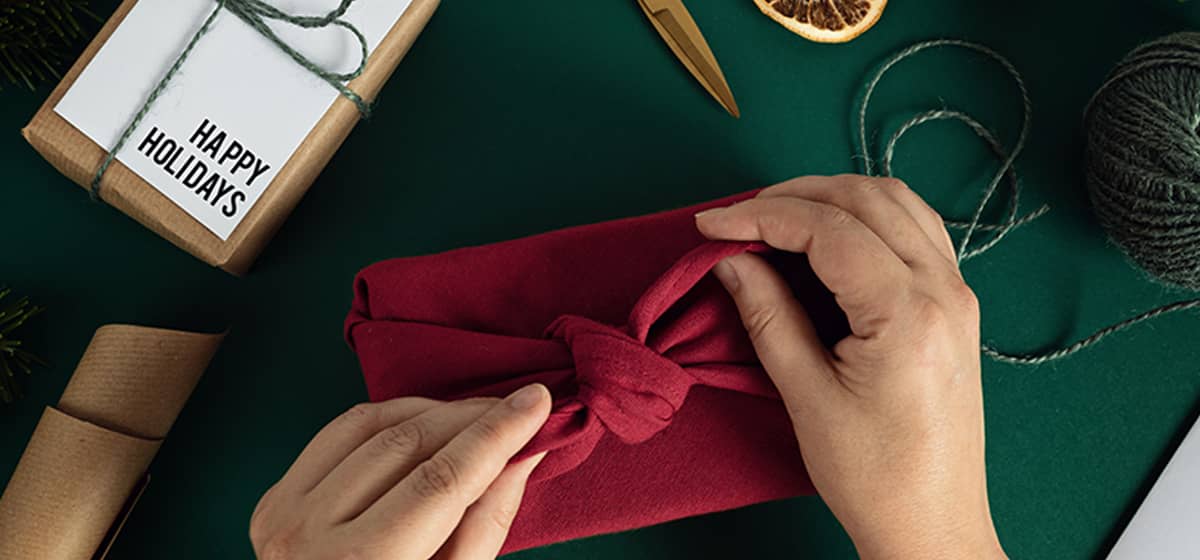
‘Tis the season to be jolly!
As we enter the most wonderful time of the year, it’s time to embark on our holiday ritual of family gathering, feasting and the best part – unwrapping of presents! While the possibilities are endless, we all know how stressful it could be when it comes to shopping for thoughtful and unique gifts for our loved ones.
Instead of purchasing the usual chocolates or coffee mug, how about thinking out of the box with eco-friendly gifts that are meaningful and good for the planet? To spread the green message this #JollyGreen season, we’ve come up with some sustainable gift ideas that are perfect for anyone you may have in mind – whether it’s your other half, your child or even your parents!
1. Beeswax Wrap
A colourful and fun replacement to single-use plastics such as clingwrap and zip lock bags, beeswax wraps are one of the latest trends in reducing waste in our homes. Made from cotton fabric and infused with pure beeswax, organic coconut or jojoba oil and tree resin, these wraps are perfect for covering a bowl of leftovers, wrapping sandwiches or even to hold fresh fruits and vegetables.
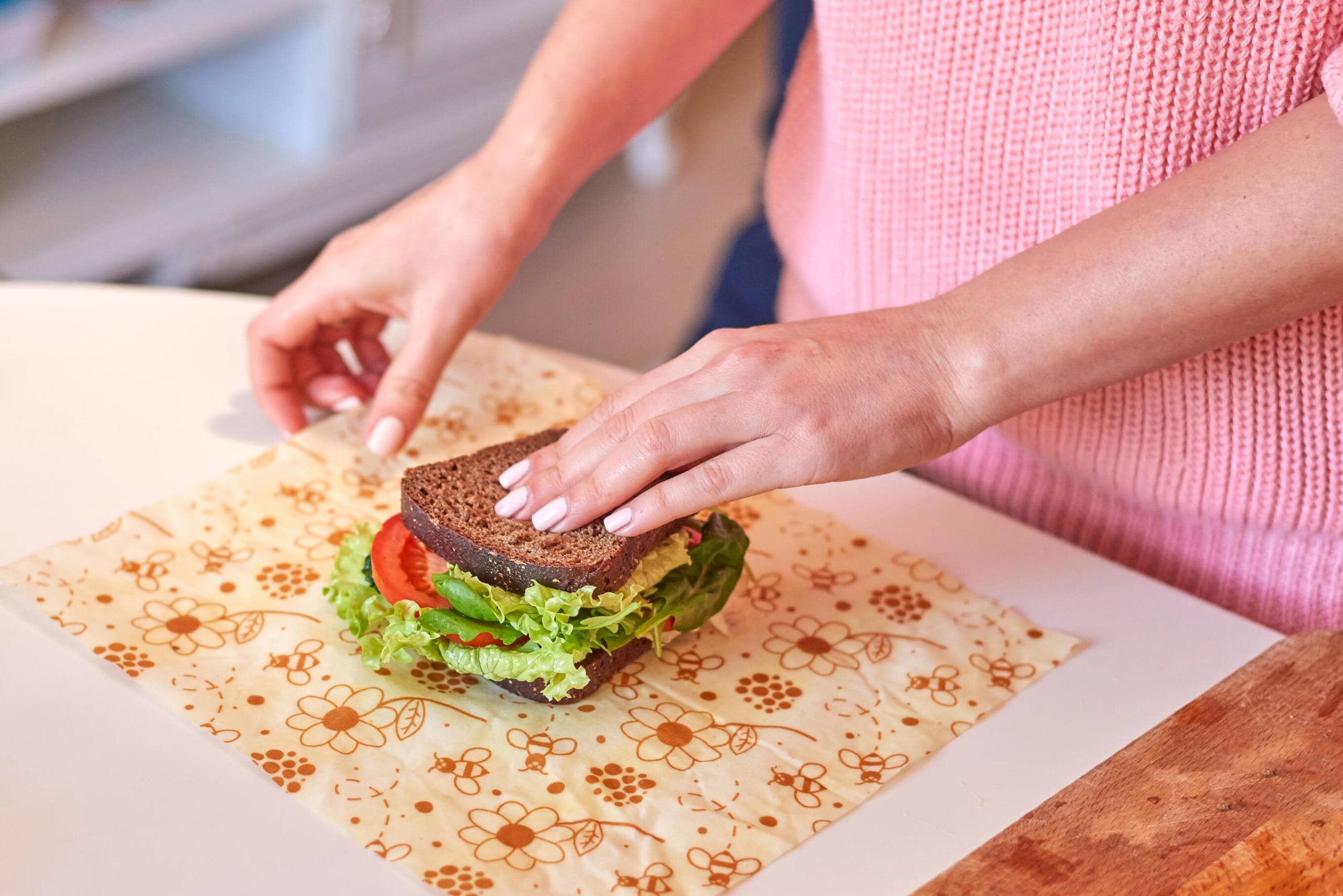
Besides having antibacterial properties that help keep our food clean and free of germs, beeswax wraps also locks in the moisture of our food to retain its freshness and flavour. In contrast, plastic wraps typically suffocate our fresh produce leading to condensation and mould forming in the bag. When this happens, it hastens the decomposition of our food and results in food waste.
Available in a myriad of designs and sizes, check out these stylish beeswax wraps at our local green brands such as Your Sustainable Store, Minimakers and The Sustainability Project.
2. Jar of Christmas Spiced Nuts
Instead of gifting the typical box of Christmas sweets packed in plastic boxes and wrappers, how about making your own festive spiced in a beautiful glass jar for a thoughtful and delicious gift! Nuts such as almonds, cashews and pecans are highly nutritious and loaded with antioxidants – a great option for your loved ones as a yummy midday snack.
Some of our favourite recipes include Jamie Oliver’s honey-roasted nuts and these maple cinnamon spiced pecans that remind us of our favourite Christmas sweets. These recipes are also a breeze to prepare – great if you’re looking to involve your kids in your Christmas preparations!
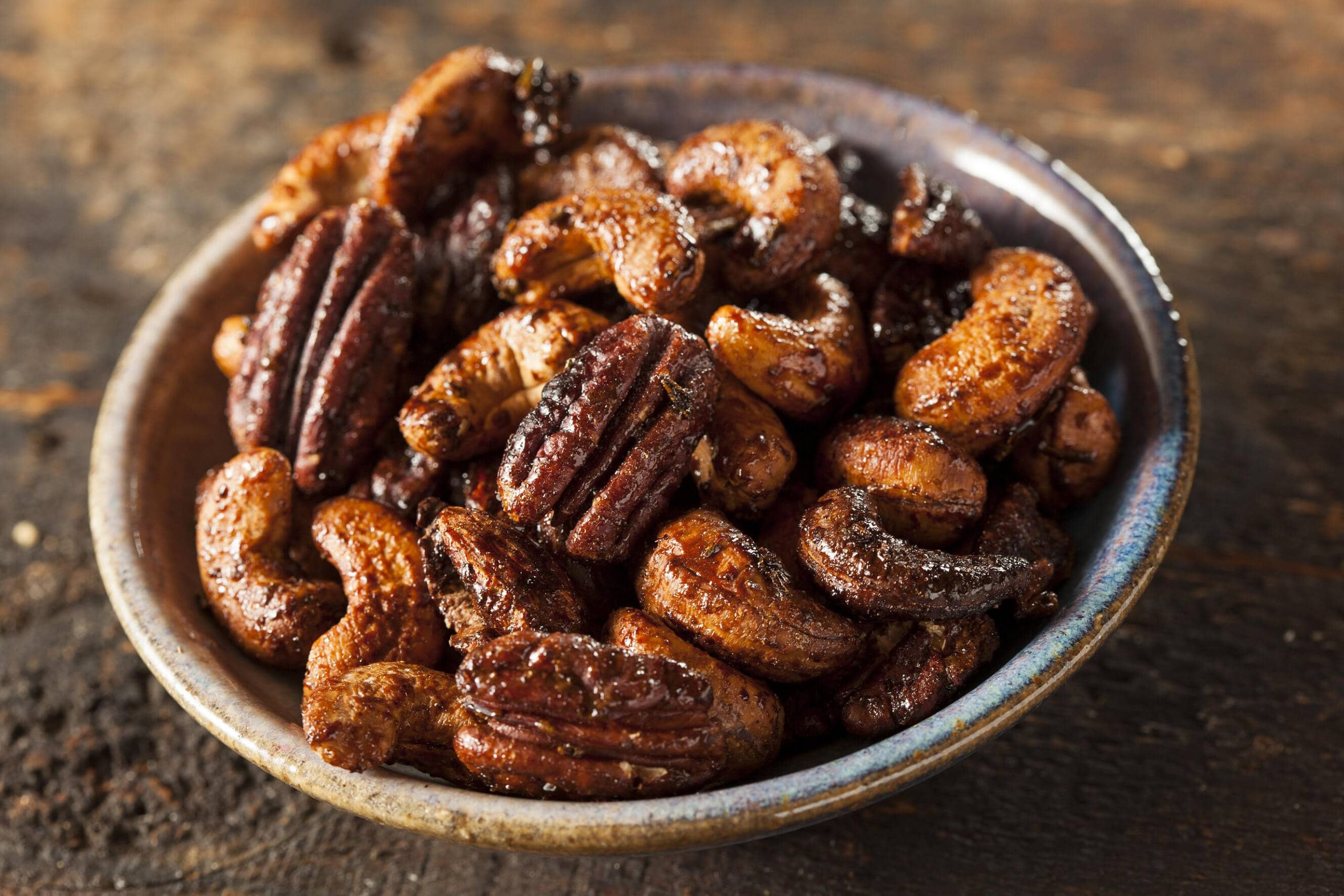
What’s more, with these glass jars, you can also encourage your loved ones to reuse them for storing other foods or even repurpose it as a mug or vase. This gift also serves as a great conversation starter to encourage them to visit zero-waste grocery stores and fill up their empty jar with the mouth-watering goodies available. Some of our favourite stores include Scoop Wholefoods, an Aussie-owned supermarket that can be found in multiple locations like Tanglin Mall and Great World City, and Unpackt, a homegrown social enterprise that offers an array of delicious snacks such as its Zesty Maple Glazed Nut Mix.
3. Edible Indoor Gardening Kit
Have someone in mind who enjoys putting meals together at home? An edible indoor gardening kit might be just the perfect gift for them! Besides bringing a pocket of green into their homes, these nifty gardening sets can also bring a splendid harvest and help your loved ones embark on a more sustainable food journey.
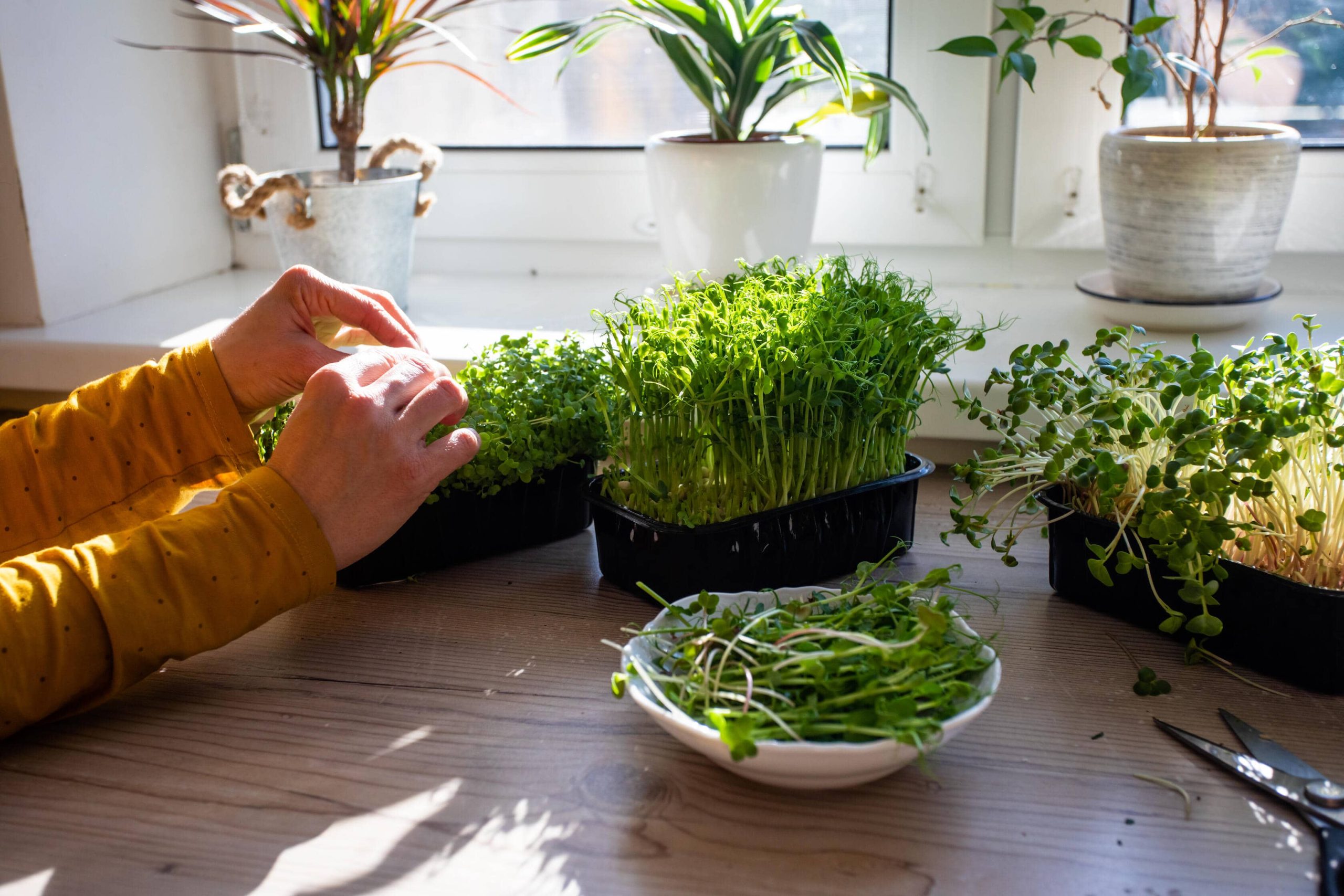
Best of all, these kits are easy to use even for those who have had zero experience in gardening! Available in a variety of options such as Basil, Kang Kong and Chye Sim, these planting sets are a gift that keeps on giving, and in a nutritious way too!
Check them out at our local brands like Root Farm and Super Farmers, where they offer microgreens sets that can easily be grown in small spaces (perfect for HDB dwellers) and only takes a week to harvest!
Gift the gift of experiences
While the above presents can certainly be meaningful, gifting an experience can also be equally or even more special! In addition to creating lasting memories with your loved ones, gifting an experience is also usually more sustainable as there is no physical gift that requires additional wrapping or packaging, thus eliminating unnecessary paper or plastic waste.
4. Treat your loved ones to a zero-waste spa session
Instead of going to the spa, where products used typically contain chemicals that are bad for the environment, how about transforming your home into a blissful sanctuary and indulging your loved ones in a zero-waste pampering routine? Best of all, you can even join in and get some much-needed TLC as we wrap up the year!
Step 1: Set the Mood
Light a scented candle like this one from Pass It On. These candles are not only made from eco-friendly materials but encourages zero-waste practices by allowing you to repurpose your empty candles into planting pots. They even come with seed paper for you to sprout a modest produce after!
Step 2: Mix your very own concoction of homemade avocadoes hair and face mask
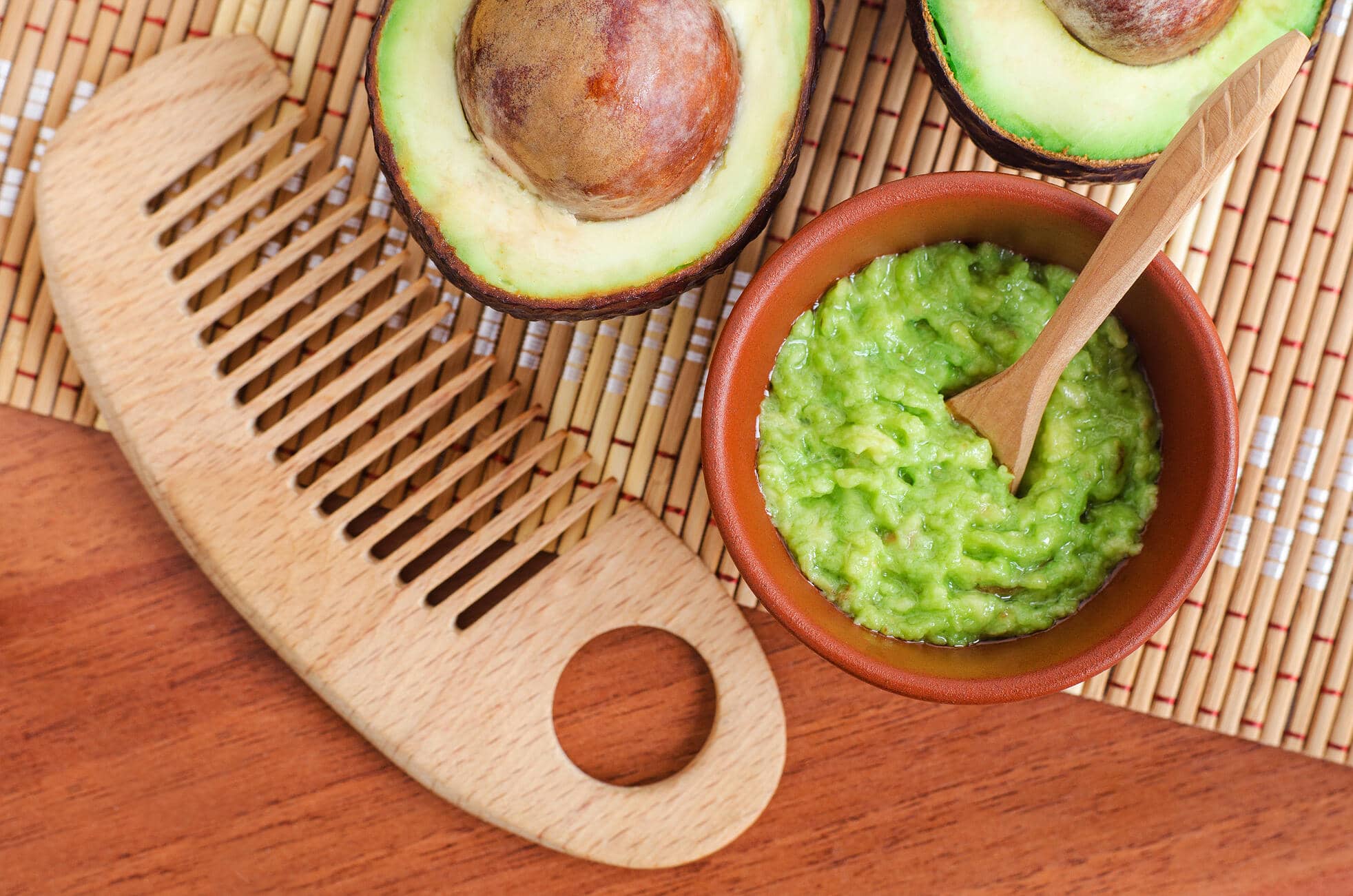
Mix your very own concoction of homemade avocadoes hair and face mask for that au naturel experience. A buttery fruit that is rich in vitamins, avocadoes are extremely nourishing as they not only high levels of minerals that would keep our loved ones’ hair smooth and shiny, but also compounds that help to protect their skin from sun damage – especially useful given that we live in sunny Singapore!
For a hydrating hair mask to lift those dull strands, mash an avocado with two ripe bananas. If you like to bring it up a notch, drip a few drops of rosemary and tea tree oil for that soothing scent. Then, slather the mixture from the tips of your loved ones’ hair and working your way up to their scalp, leaving it on for a good 20 minutes before rinsing off thoroughly.
And for a purifying mask to brighten up your skin, pit half a ripe avocado, add a tablespoon of solid coconut oil, and a teaspoon of honey and water. Gently massage this creamy concoction on their face and leave it on for 15 minutes to absorb all the nutritious goodness. While the avocado moisturises the skin, the honey and coconut oil can help to fight minor acne and inflammation.
Step 3: Rejuvenating body scrub experience
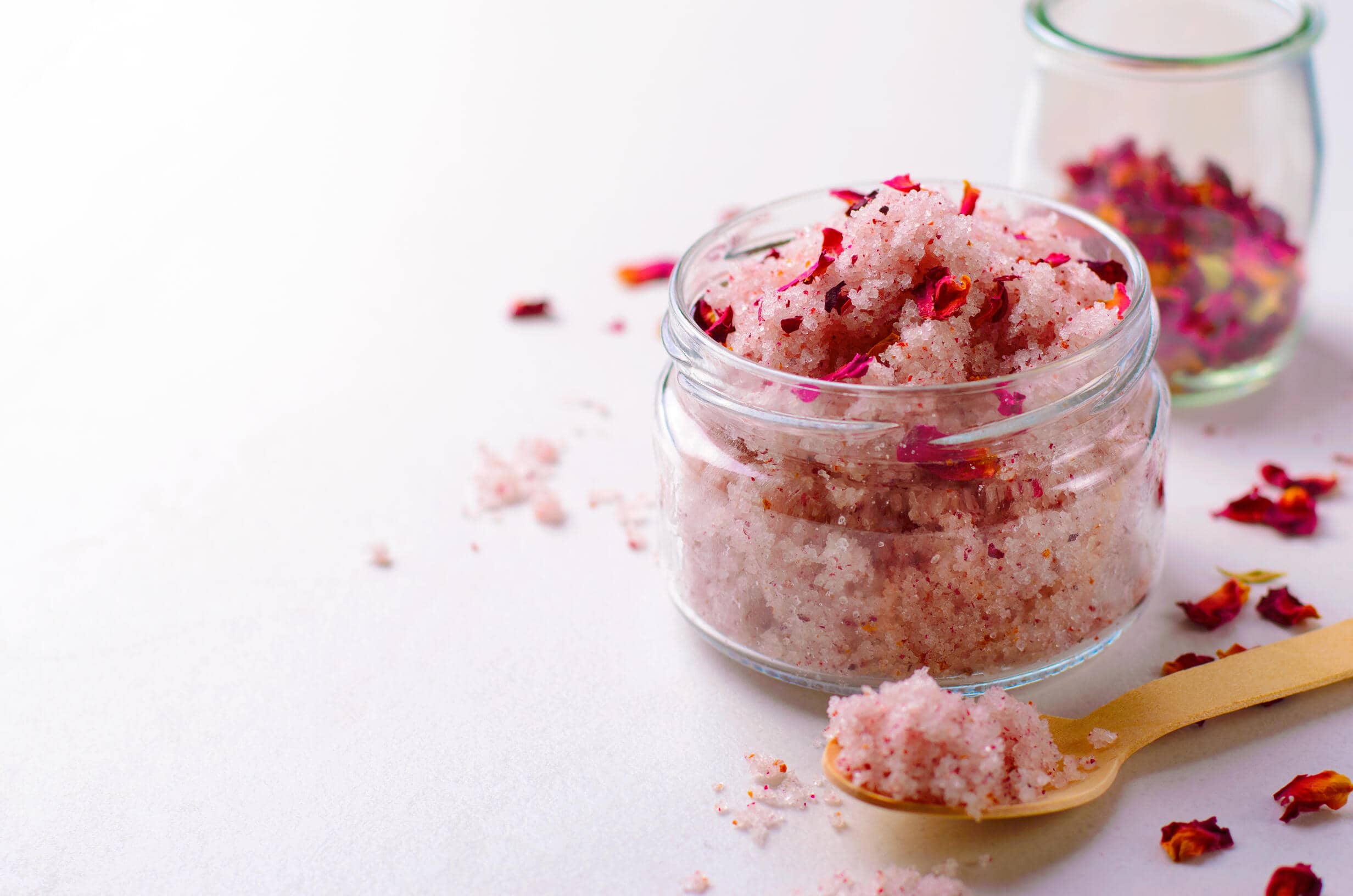
Finally, give them a full rejuvenation with a natural homemade sugar scrub that can easily be put together with ingredients found in your kitchen in less than 10 minutes. Simply combine equal portions of brown sugar and coconut or olive oil, mix them thoroughly and voila; you’re done!
For those of us looking to gift a more luxurious experience, our Changemaker Cultivate Central has the perfect recipe right here that is infused with floral botanicals like Citonella, Lemon balm and Globe Amaranth flowers. The wonderful scents from these herbs also provide mood lifting and stress relieving properties! Give these DIY recipes a try to make your skin feel incredibly soft and hydrated in no time.
5. Experience nature’s gifts
If you’re still looking for a great gift for your kids, how about bringing them closer to nature with an outdoor tour with EcoTrail that casts a spotlight on the everyday ecosystems in Singapore? This 1.5 hour-long guided tour includes multiple stations with activities such as chicken feeding, planting organic fruits and vegetables, and even learning about how solar plants and incubators work! Immerse yourself in the beauty of our local nature and relish the fresh air, lush greenery and clear blue skies in this private farmland – it’s a great gift to quench the curious minds of our little ones while showing them the beauty of our Mother Nature.
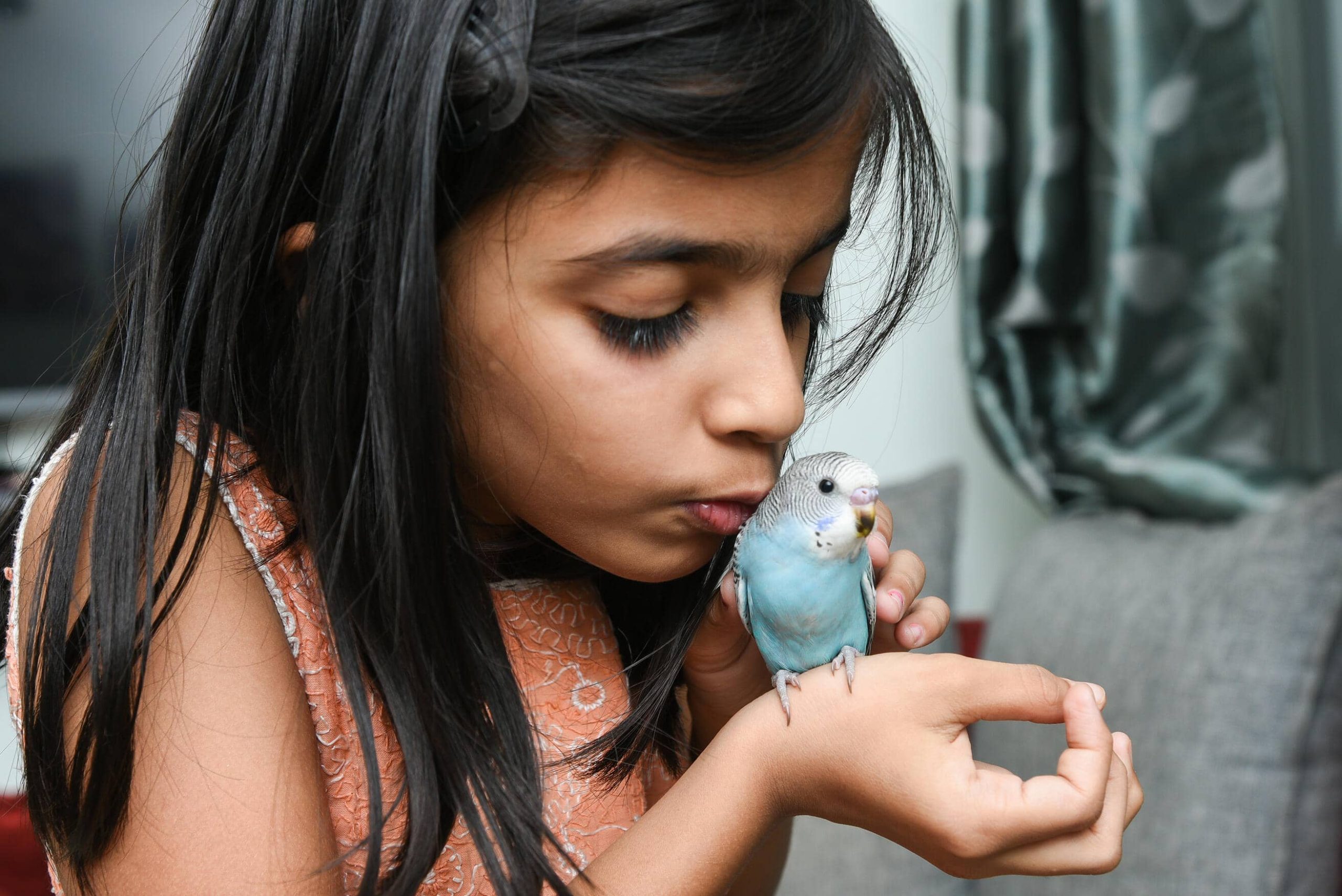
Alternatively, check out The Sundowner’s rooftop farm experience that is great for adults and children alike. Enjoy an organic farming class where you learn all the secrets of creating a healthy soil for the freshest harvest, come up close and personal with honeybees, and delight in a farm-to-table honey tasting to round it all up! Best of all, take in the beautiful sunset as you enjoy this one-of-a-kind rooftop experience in Singapore. This is one hidden gem that will be the perfect gift for any loved one!
This holiday season, go beyond embarking on your own green journey to encourage your loved ones to take the first step. Be it a physical gift or experiences, what matters is the thought that counts!
Here’s wishing you and your loved ones a merry and #JollyGreen holiday!
Image Credits: Nylon Coffee Roasters
Source: The Sustainability Project
How to make your own tea blend
- Home
- 2021
[Post Date]
How to make your own tea blend

Tea is the most popular beverage in the world, placing ahead of other well-loved beverages such as juices, beer and even coffee. This is unsurprising since there is a tea perfect for every occasion – whether an English Breakfast as a perk-me-up in the morning or a calming chamomile as part of your nightly wind down routine.
Besides being as a tasty drink to sip on, tea is also known for offering plenty of health and wellness benefits. According to HealthHub, tea contains high antioxidant levels which helps in high antioxidant levels which helps in reducing the risk of cardiovascular disease.
In addition, studies have also shown that teas can help in boosting our immune system, fight off inflammation and even minimise the likelihood of cancer and stroke.
For those of us weary and stressed from working from home, brewing a quick cup of lavender or mint tea can also introduce a little pocket of zen into our daily routine and serve as a great stress reliever!
However, while you can easily purchase tea blends from stores, high quality tea blends may be relatively costly. Some manufactured blends may even make use of artificial flavourings, which may be bad for our health in the long run.
The many benefits of making your own tea blend
Instead of buying pre-packaged tea, how about choosing to make your own custom tea blend? By purchasing loose tea leaves and herbs, it not only ensures a fresher and more robust taste but also promises for you to benefit from its higher nutritional value.
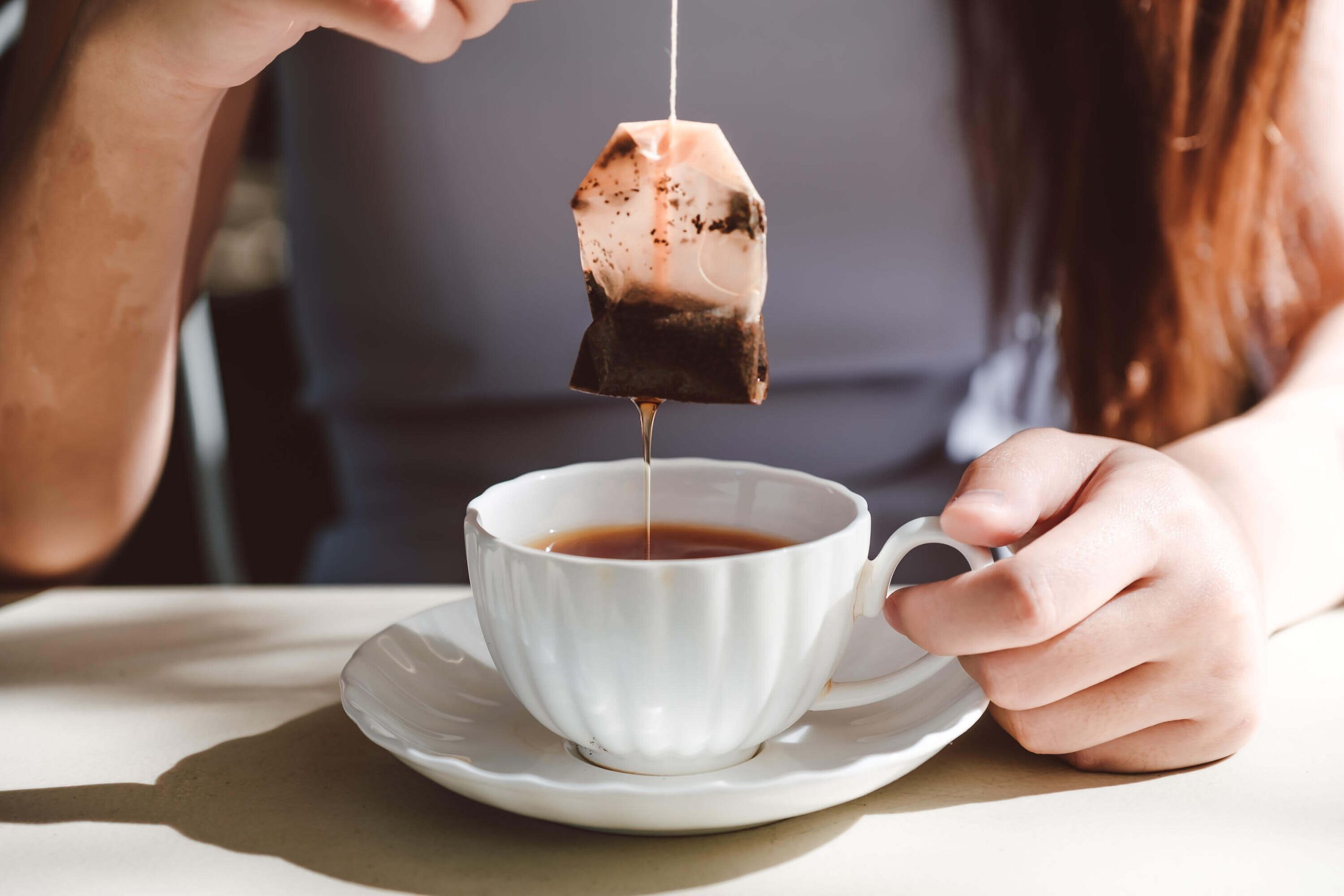
Beyond the taste and health advantages, brewing tea from loose leaves is also better for the environment! Often, teabags contain a small amount of plastic as manufacturers aim to enhance the durability of tea bags in hot water. When seeping our teabags, these micro plastics get broken down where we end up consuming them. Over long periods of time, this may result in many health issues. With its plastic contents, teabags also cannot decompose completely – just like plastic bags or plastic utensils – which makes them harmful to the environment.
So how can we make our own homemade tea blends? Here are three simple steps for you to do so, which can be easily customised to your personal nutrition goals and flavour liking. To ensure a well-balanced tea profile, each herb is measured in teaspoon proportions and can be brewed for 2-3 cups of tea.
Step 1 – Choose your blend bases
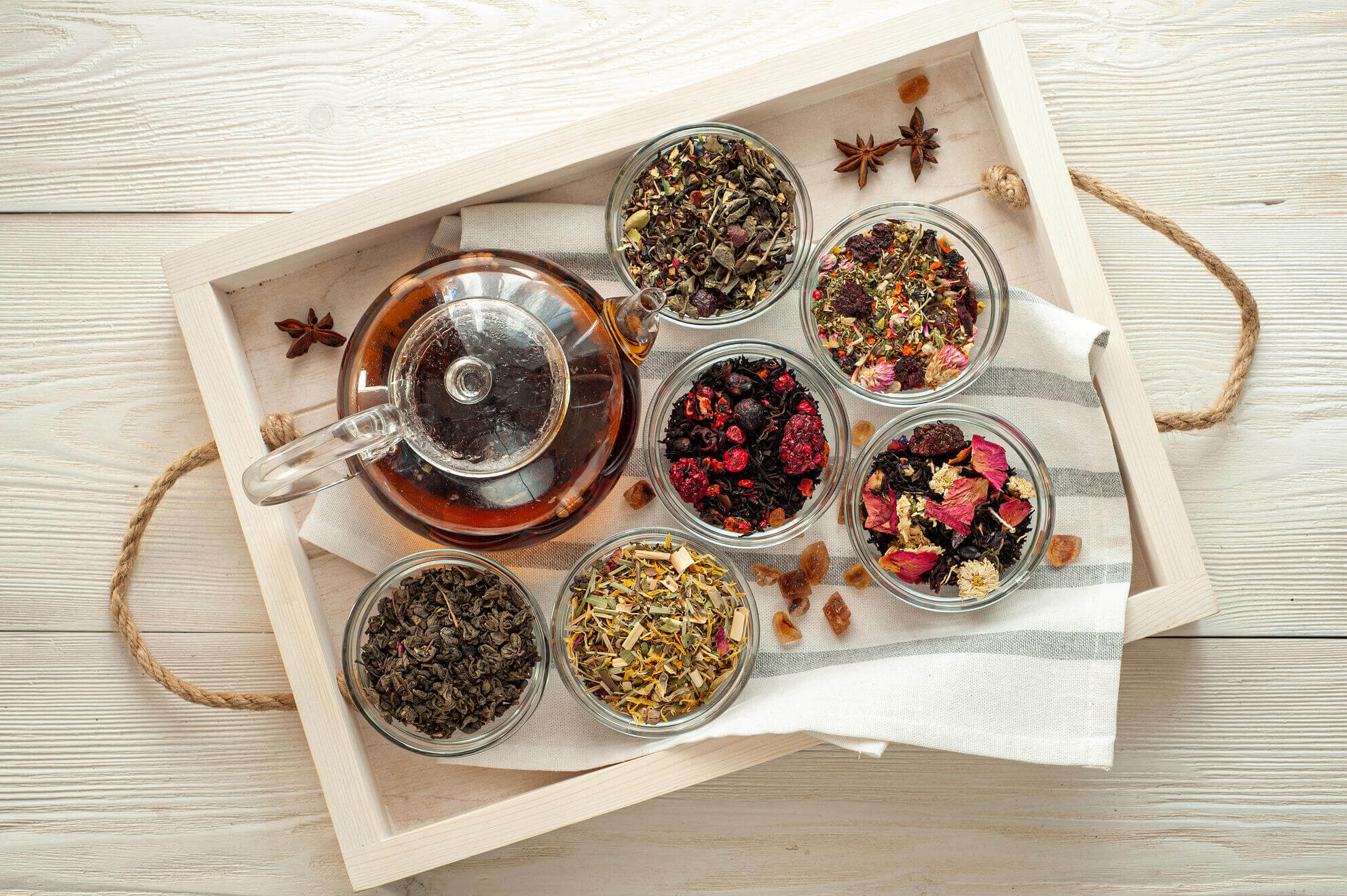
To begin, start off by identifying the purpose of your tea blend.
Are you looking to craft a blend that gives you a midday brain boost or to serve as a soothing end to your day? For those of us who experience bloating after a heavy meal, certain teas can also aid our digestion and help our bodies metabolise our food to reduce the discomfort.
Once we’ve identified the purpose of our tea, it’s time to choose the base herb! Some of the more commonly used base herbs include chamomile, which is known for its calming quality, peppermint that promotes alertness, and rosemary, which helps in improving our cognitive function. As this blend base builds the foundation of your tea, include 3 teaspoons for sufficient flavour.
Step 2 – Identify your complementary herb
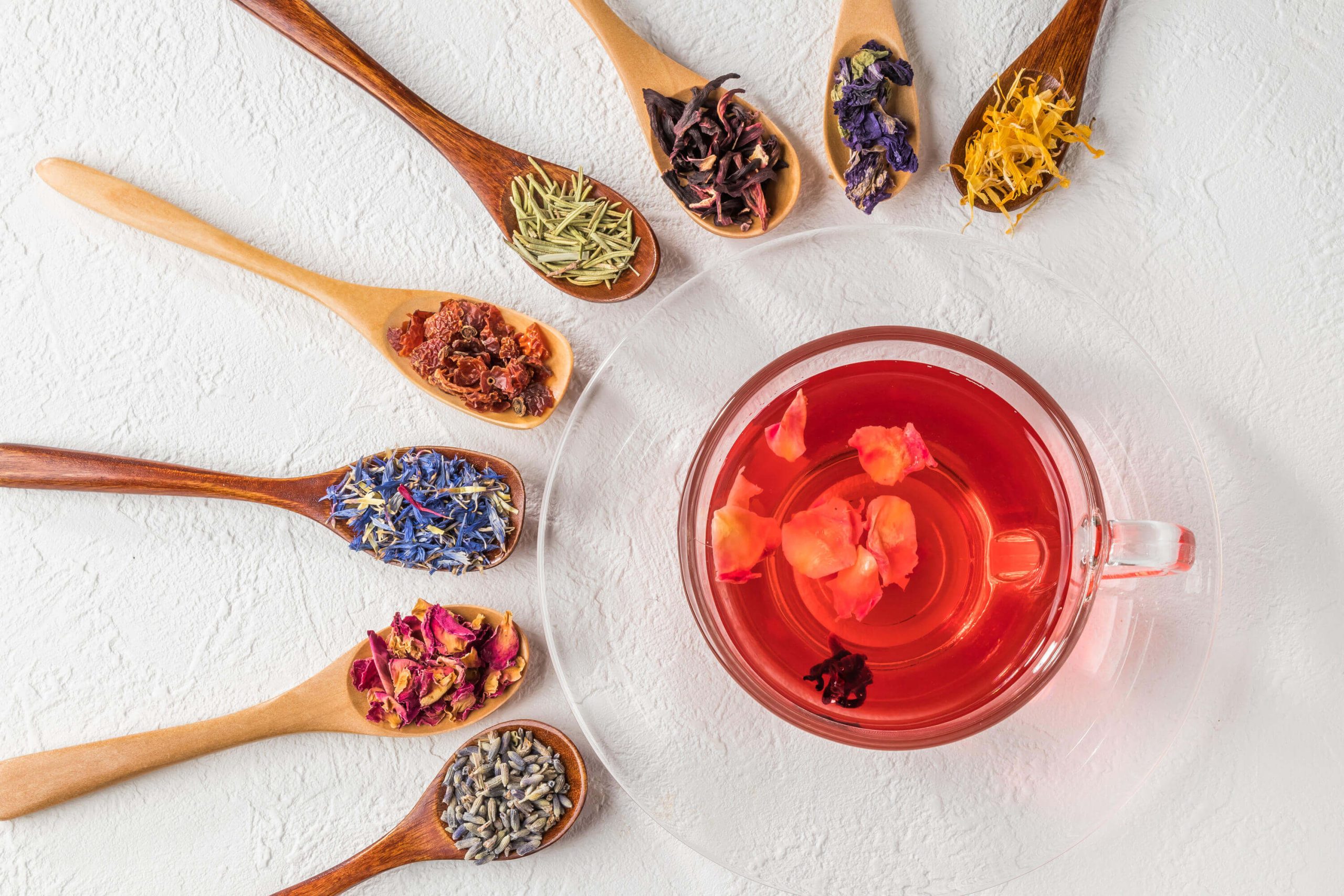
Next, you’ll need to choose your second-most dominant herb in your tea recipe. Depending on your blend’s base, this complementary herb can either help tone down the intensity of the main tea base or enhance its flavour and add to its profile complexity.
For our health junkies looking to make the most out of each cup of tea, you can also choose a complementary herb that offers additional health benefits! While there are no limits to which herbs to use as a complementary option, some of the more common choices are floral notes such as lavender, rosemary and elderberry. A few examples of this would be common favourites such as Jasmine Green Tea or Osmanthus White Tea. For this, add in 1 to 2 teaspoons into your tea blend.
Step 3 – Finish off with an accent herb
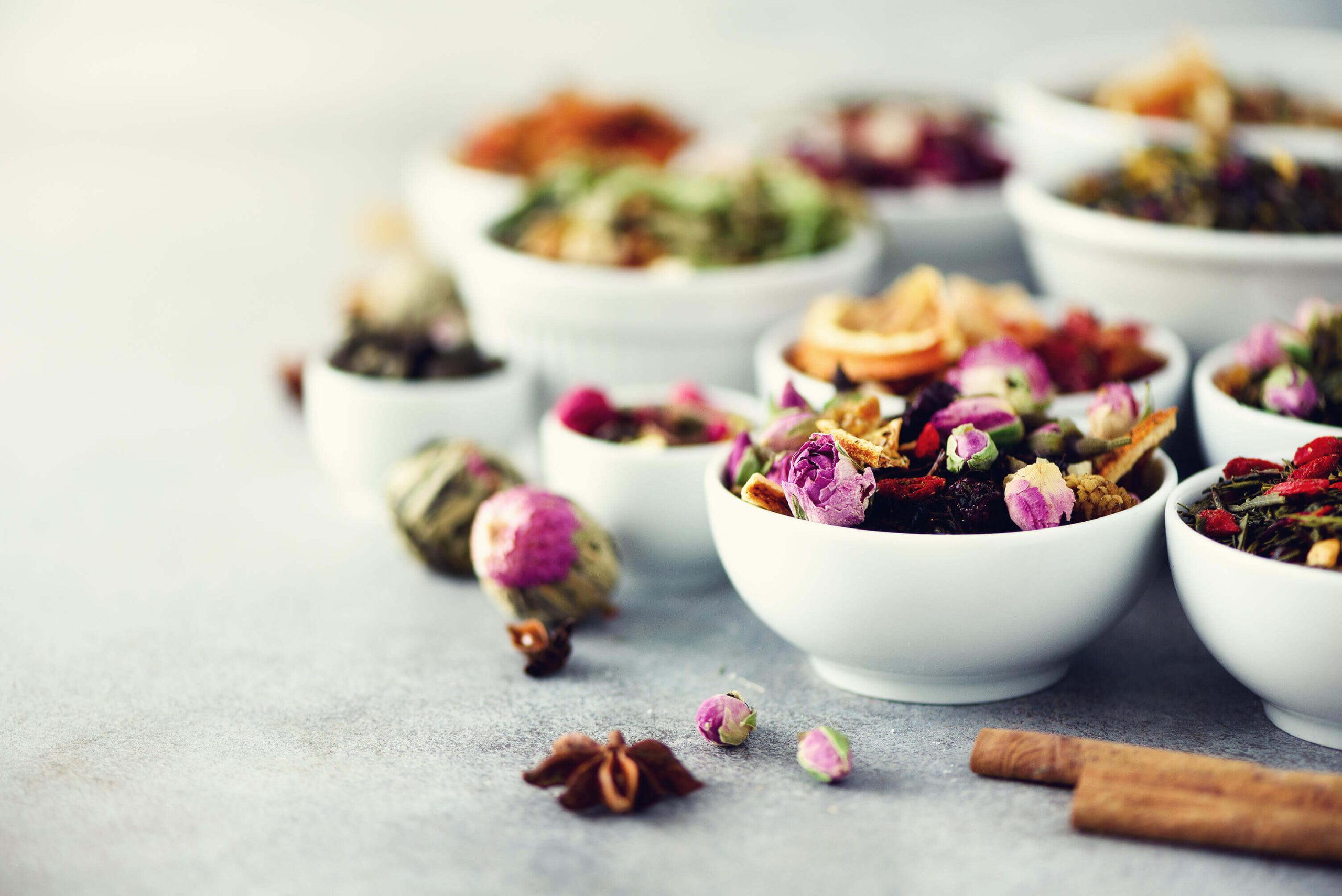
Finally, to round out the tasting notes of the first two ingredients, choose an herb that offers that delightful pop of flavour. Again, there are no boundaries as to which herbs you can use. You may choose either one of the aforementioned herbs, or even pick a personal favourite spice like nutmeg or cinnamon. For those who enjoy floral teas, wild rosebuds work perfectly for that delicious aftertaste.
For this accent herb, mix in just ½ to 1 teaspoon so that it does not overpower the overall tea flavour.
And there you have it! Your very own tea blend made for any occasion. As with any DIY, this is very much a trial-and-error process, and we encourage you not to be disheartened if you do not nail the yummiest blend on your first try – it’s perfectly normal!
If you’re looking for some tried-and-tested recipes as a first step, feel free to check out some delicious blends here! However, if you’re one of the more adventurous amongst us who’d prefer to experiment, here’s a tea blending template that we hope will help you along your DIY tea blending journey.
As we #PowerTheChange one cup of tea at a time, check out the range of herbs and loose tea leaves available at Unpackt, one of Singapore’s zero-waste grocery stores! Reduce unnecessary plastic packaging by bringing along your own reusable containers, such as airtight glass jars, to store the ingredients you need and keep them fresher for longer periods of time!
You can also spread the #JollyGreen spirit by making your own tea blends for your loved ones which not only serves as a great conversation starter to encourage them to go green for our environment, they are also thoughtful gifts to nudge them on a health-boosting tea journey!
Image Credits: Nylon Coffee Roasters
Source: The Sustainability Project
3 easy twists to spice up your vegan dishes
- Home
- 2021
[Post Date]
3 easy twists to spice up your vegan dishes
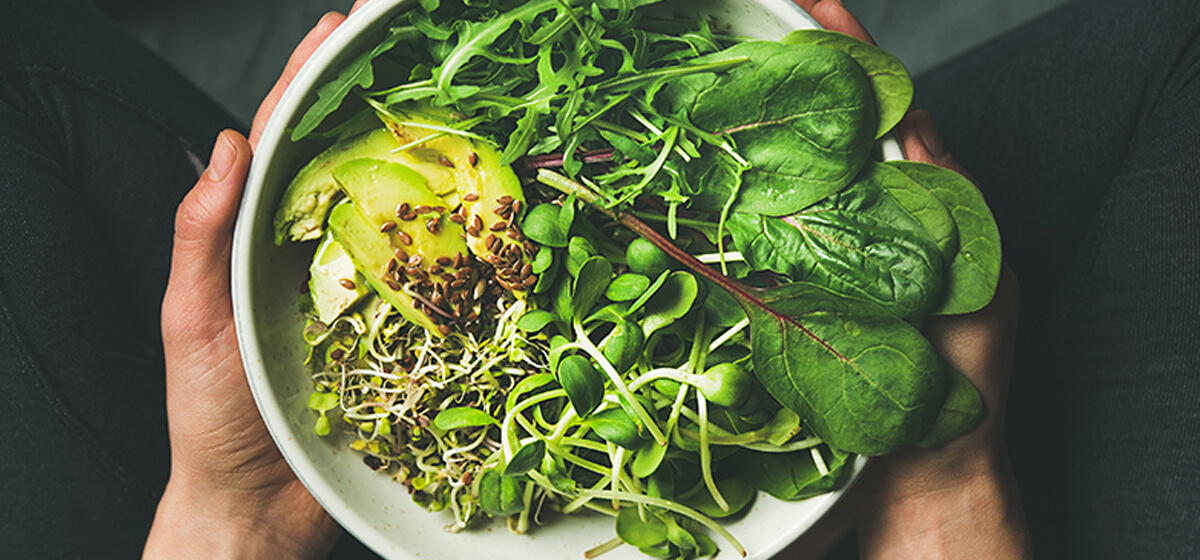
World Vegan Day was recently marked on 1 November where individuals around the world celebrated all things plant-based and the benefits of a vegan lifestyle. This year, it coincides with the beginning of the 26th United Nations Climate Change Conference of the Parties (COP26), where leaders across the world came together to discuss how to mitigate climate change.
According to research published in 2019, it uncovered that animal agriculture is responsible for 87%1 of greenhouse gas emissions and is the leading cause of climate change. Greening your diet is also the most effective way to reduce emissions.
As conversations surrounding global warming continues heating up, this timing serves as a fitting reminder as to what we can do through our everyday diets to combat climate change.
Going beyond the daily recycling and plastic-free efforts and in celebration of World Vegan Day, we’ve listed three easy ways you can give existing plant-based recipes a little twist when whipping up some vegan-friendly meals to share with your loved ones and get them onboard the green movement. Not only does this do good for the environment, it brings us numerous health benefits as well!
1. Swapping for a tofu patty into your sandwich
While one may often think of simply excluding a meat patty to keep our sandwiches vegan friendly, how about swapping it for a tofu “patty” to spice things up a little? These tofu patties are a great source or proteins and amino acids, which makes them a good and flavourful substitute for our regular meat patties!
To make these tofu patties, simply squeeze the excess water out of your block of firm tofu before marinating it with a combination of salt, pepper, garlic and onion powder. Then, coat each piece of tofu evenly with all-purpose flour and pan-fry them over medium heat until golden brown.
To make for a nutritious meal, assemble your sandwich with an array of vegetables – lettuce, tomatoes, cucumbers are our favourite!
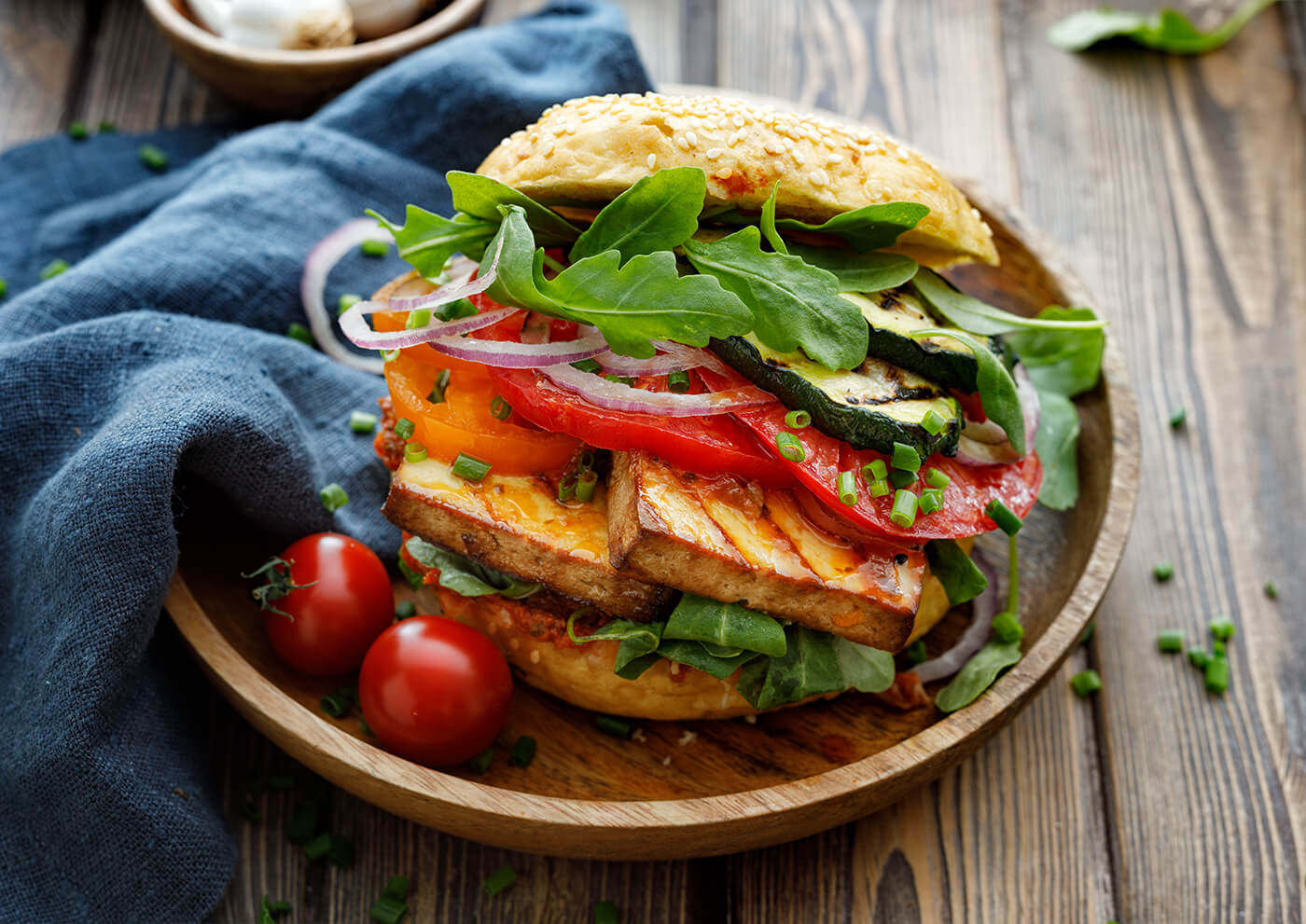
Take a step further on your sustainability journey by supporting local vegetables producer such as our Changemaker – ComCrop, for their range of locally grown produce, which includes the freshest Ruby Red and Emerald Green Lettuce – perfect additions to your sandwich.
You can also check out this tofu patty sandwich recipe – a perfect option if you’re looking for an easy meal on-the-go or for an outdoor picnic!
2. Switching up regular pasta for zucchini noodles
Hands up if you’re a big lover of pasta! As one of the easiest meals to whip up and easily personalised to our own liking, it’s no surprise that pasta is one of the world’s most well-loved dishes.
While we can easily opt for an all greens no meat pasta, how about switching things up and making zucchini noodles instead? This tasty alternative is not only a lighter option to carb-heavy pasta, but also a great source of vitamin C, vitamin A, potassium and iron. What’s more, its high-water content means it will keep you feeling full for a longer period of time, and it’s a great way to get those extra veggies into your diet!
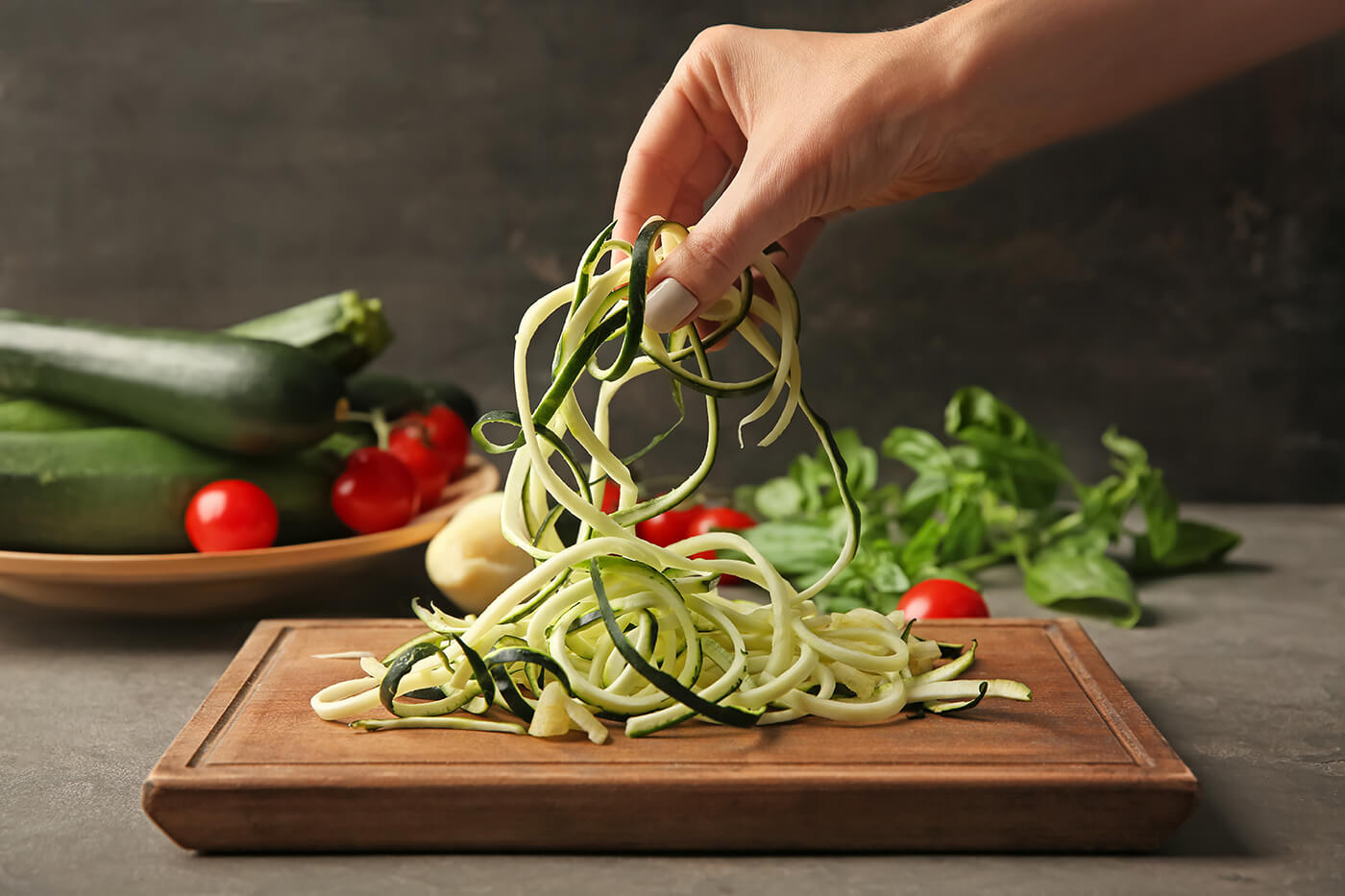
To make zucchini noodles, simply use a spiralizer to slice your zucchini into long ribbons.
Pro tip: When choosing your zucchini, opt for one that is slightly firm and has a glossy finish on its skin to prevent the zucchini noodles from turning out too mushy.
Thereafter, toss it in your favourite tomato-based pasta sauce and voilà! If you’re looking for a healthier pasta sauce alternative, you can also check out Comcrop’s delicious pesto rendition, made from the freshest basil grown locally!
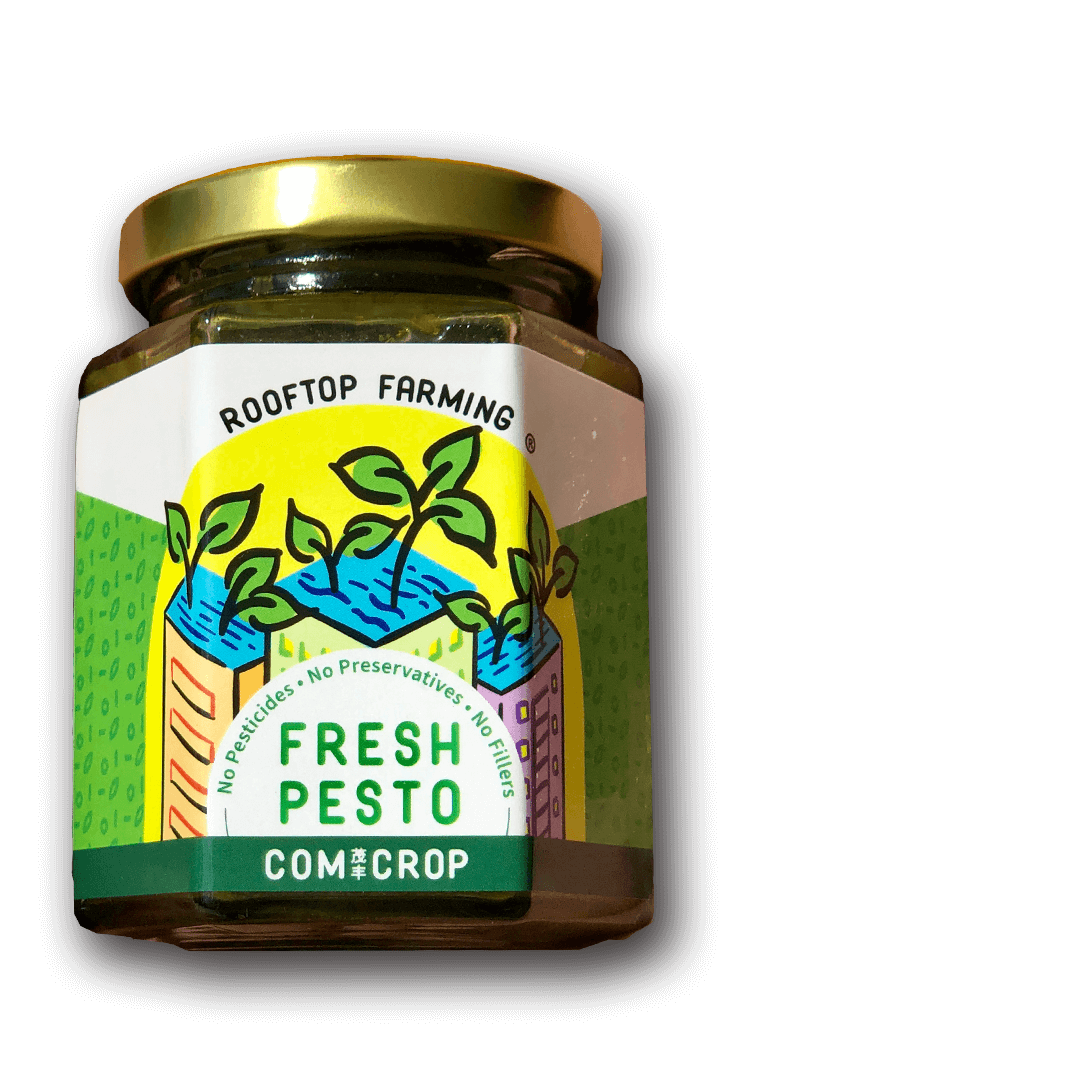
If you prefer making your pesto from scratch, check out this zucchini noodles pesto pasta recipe, that includes a step-by-step guide to making your own fresh pesto. Delicious!
3. Grated cauliflower in replacement of rice
If you lean towards an Asian palate, how about trying your hand at cauliflower fried rice? Instead of using regular rice, grated cauliflower is a yummy alternative that is not only healthier but hearty enough to serve as a main course.
In addition, these florets pack a load of vitamins and minerals. Being high in fibre, it not only promotes feelings of fullness but also helps to feed the healthy bacteria in your gut. To make cauliflower rice, start by washing them thoroughly before chopping it up into large chunks and grating them individually with a grater.
Quick tip: Use a medium-sized hole grater to achieve pieces that best imitate the texture of cooked rice.
Then, simply sauté them over medium heat with the rest of your ingredients like how you’d normally do when preparing regular fried rice. Lightly stir-fry till the cauliflower is slightly crispy on the outside but tender on the inside. Click here for the full recipe that also offers some vegan alternatives to our usual fried rice ingredients!
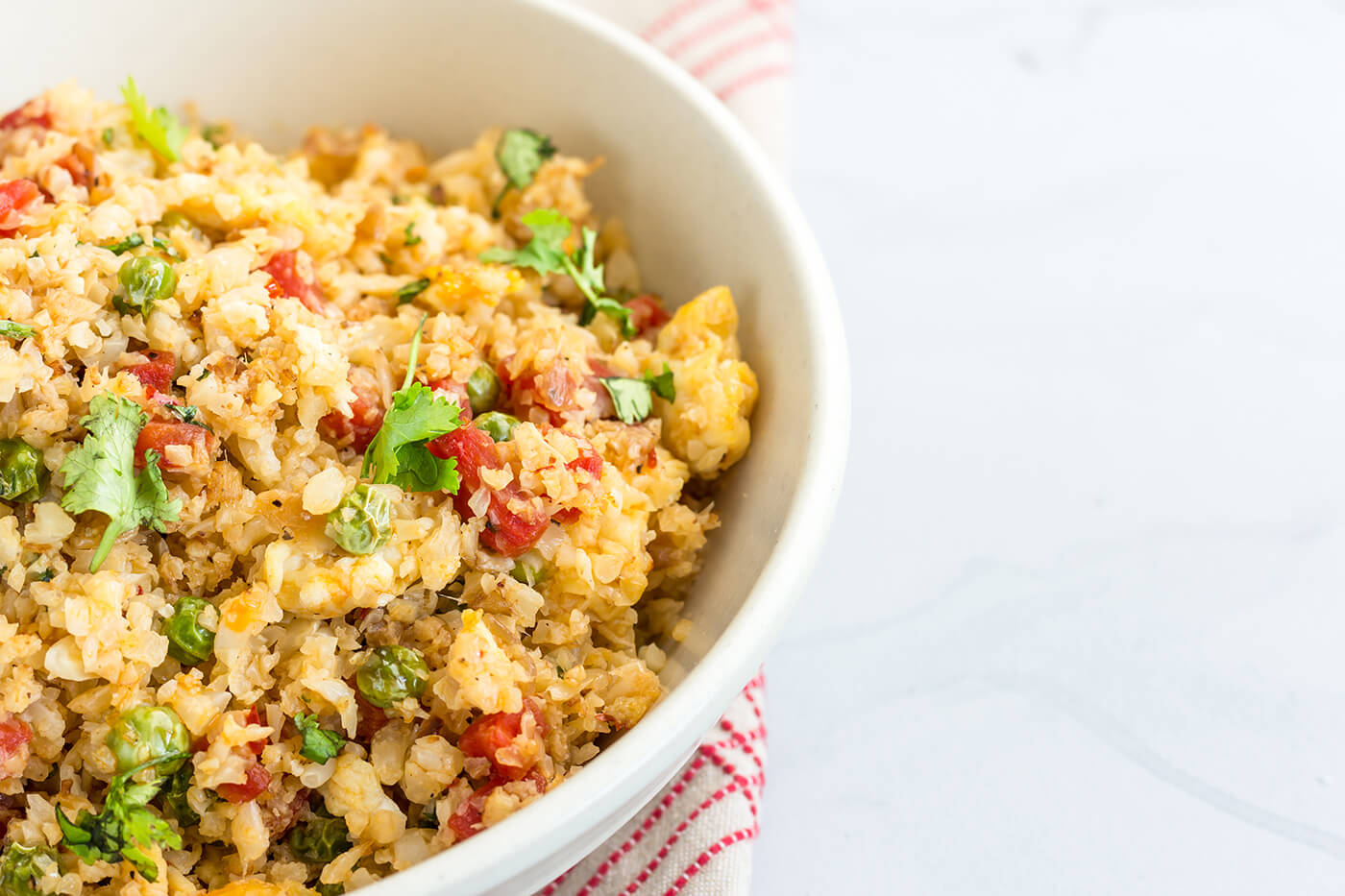
For a refreshing garnish to your fried rice, we’d highly recommend throwing in some microgreens. Though miniscule in size, these tiny greens pack a nutritional punch and delightful flavour. Best of all, they can be easily grown in small spaces, are easy to care for and only takes about a week to harvest! To learn how to grow your own microgreens, check out another of our Changemakers – Cultivate Central, for their tips to get started!
We hope these three suggestions help inspire you to recreate some of your favourite dishes so that they’re not just yummy but also better for Mother Earth. As we approach the year-end holidays, let’s #PowerTheChange and be #JollyGreen together by challenging ourselves to brainstorm some tasty vegan recipes for a greener year in 2022!
Image Credits: Nylon Coffee Roasters
Source: The Sustainability Project
References:
- 1 (2019) Climate Healers, Animal Agriculture is the Leading Cause of Climate Change – A Position Paper https://climatehealers.org/the-science/animal-agriculture-position-paper/
4 lesser-known trails for your next green adventure
- Home
- 2021
[Post Date]
4 lesser-known trails for your next green adventure
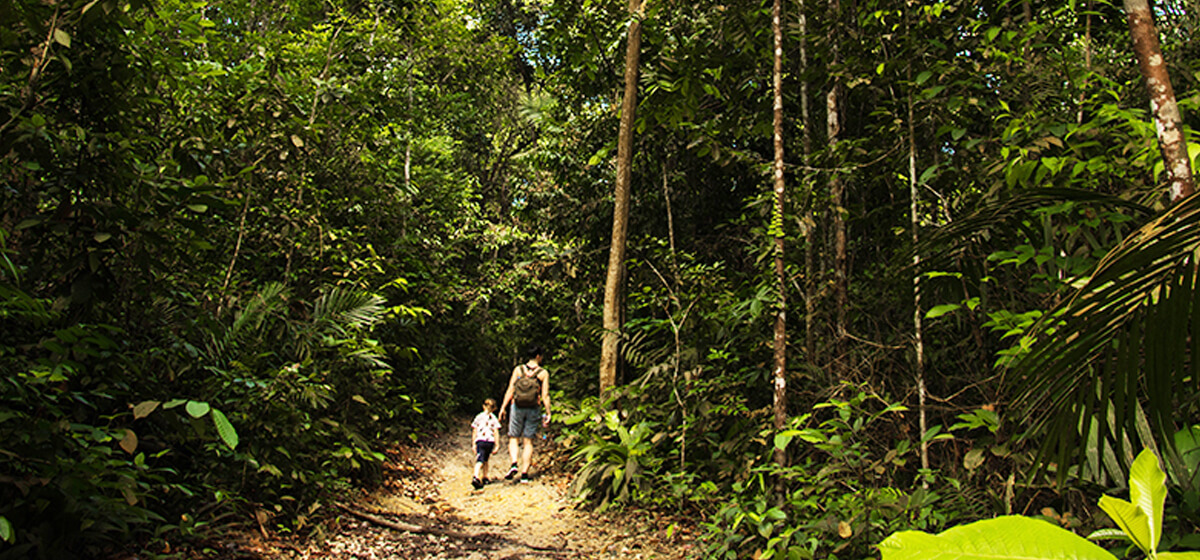
Singapore has a multitude of parks and nature reserves hidden amidst our concrete jungle. With more than 350 nature spots and a variety of forested hills and swampy wetlands, there is no lack of options to escape the hustle and bustle of the city and immerse in the natural beauty of our tropical island.
However, as we continue exploring these scenic routes in Singapore, are we ensuring that we are hiking sustainably? For our little red dot, each pocket of nature is carefully managed to conserve the area’s natural state, providing us much needed respite from our daily lives. We all have a part to play to preserve these green spaces for our future generations in the years to come.
One simple way to be eco-friendly is by visiting lesser-known parks and nature reserves to minimise the issue of overcrowding. By doing so, we reduce the stresses the more popular nature trails face and allow them more opportunities to regenerate.
As we approach the school holidays, we’ve put together four lesser-known nature walks in Singapore for your next adventure, together with easy tips to hike more mindfully and sustainably.
1. Tampines Eco Green
Tucked away in the heart of Tampines is a sprawling 36.5-hectare green sanctuary known as Tampines Eco Green. Resembling a rustic savannah with marshlands, secondary forests and freshwater ponds, the park is home to over a hundred species of birds, butterflies and dragonflies – perfect for those who enjoy spotting wildlife!
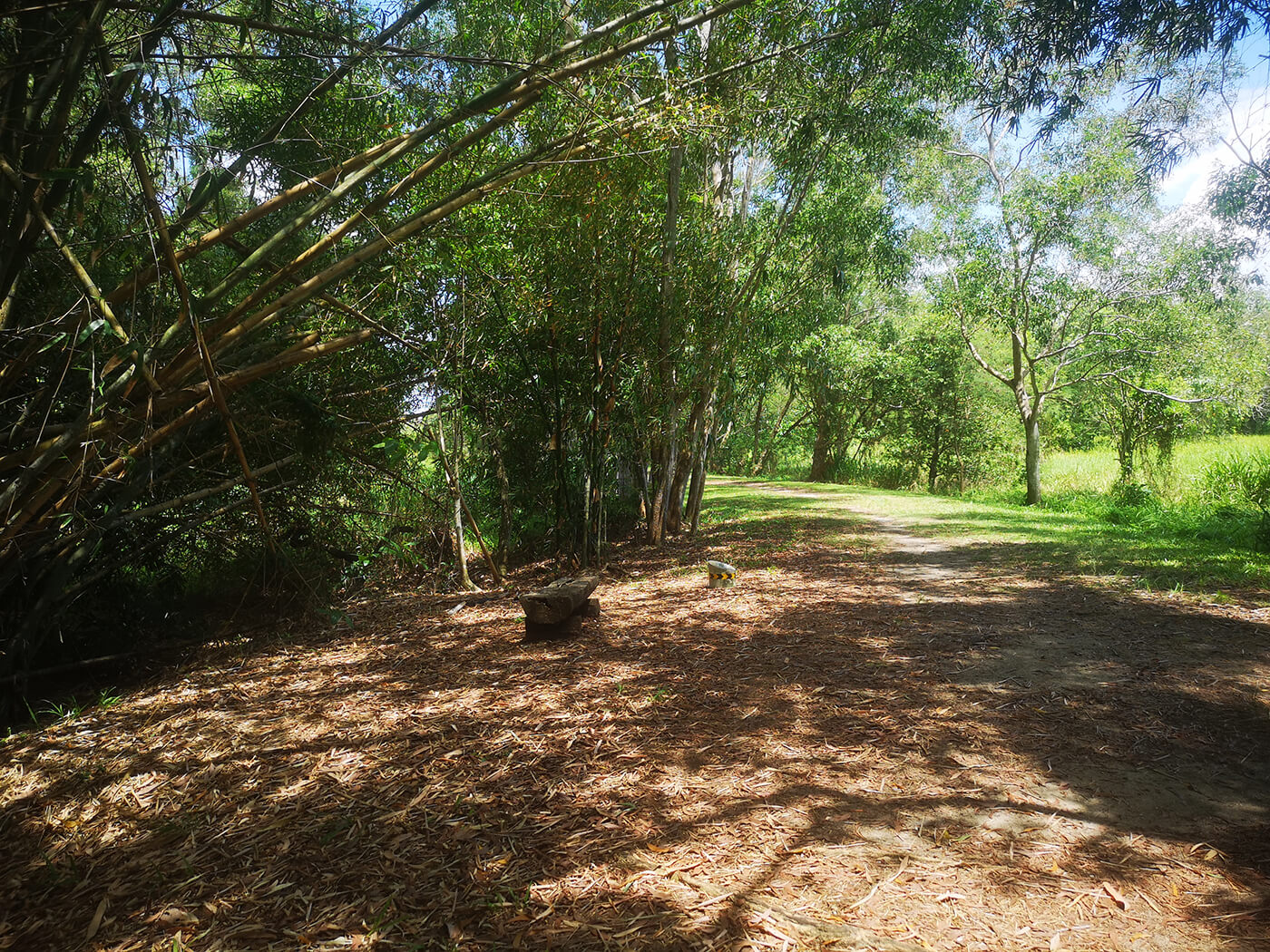
Tampines Eco Green prides itself as an ecologically conscious park that features an eco-toilet, vegetated swales, and bird hides. Everything from its sign boards to park furniture are made from recycled and eco-friendly materials! With three different trails – Diversity Trail, Forest Trail and Marsh Trail – to choose from, you’ll be sure to discover something new with each visit.
P.S. Do plan your visit earlier in the day as the park is not lit at night to minimise disturbance to the wildlife in the park.
Click here for directions on how to get there.
Green Tip: Stick to established trails when hiking
While we may be tempted to go off-trail and explore an untouched area of the park when you spot or discover something interesting, it is important to remember that we should still keep to the designated paths to avoid causing damage to the natural environment.
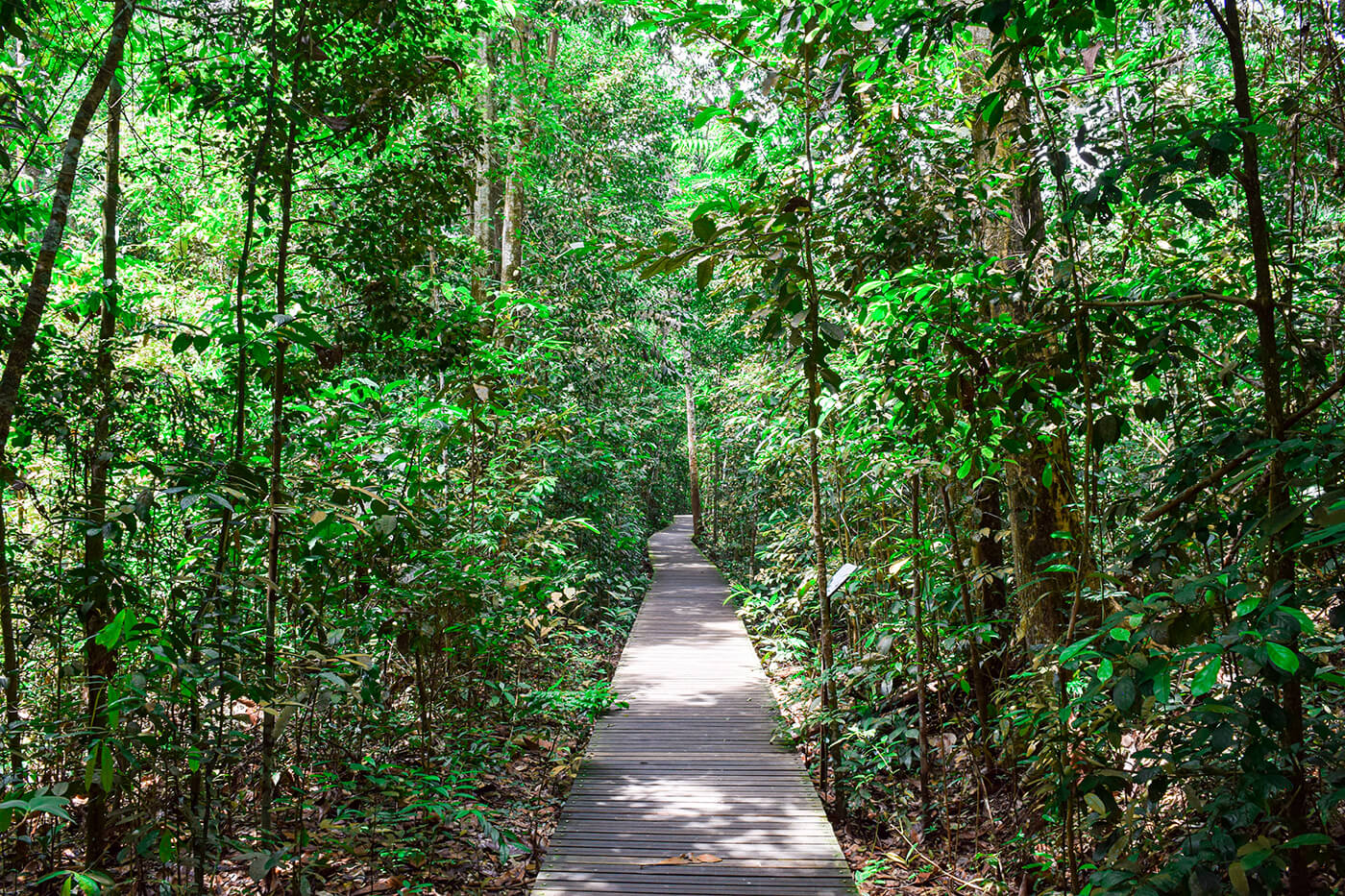
By being a non-intrusive hiker, this will not only help to protect the various species of flora and fauna but also minimise any unnecessary disruption into the lives of the wildlife.
2. North-Eastern Riverine Loop
Meandering through the Punggol district is the North-Eastern Riverine Loop that boasts beautiful views of glittering reservoirs and waterways. With a variety of birds, animals and plants that call it home, this park connector is an undeniable delight for nature lovers.
Spanning 26km, the North-Eastern Riverine Loop is perfect for anyone looking for a full day of exploration! What’s more, check out the various picturesque spots that can’t be missed including the Lorong Halus Bridge, Punggol Promenade Punggol Point Walk and Kelong Bridge. If you prefer to cycle, we’d recommend beginning your journey at Punggol Park where bicycle rentals are available.
Click here for directions on how to get there.
Green Tip: Do not feed the wildlife
While we may want to feed animals that we come across during our hikes out of compassion, doing so actually does more harm than good. Feeding wildlife alters their behaviour and may lead to them associating humans with food. This often results in undesirable consequences such as the animals grabbing food from passing individuals and losing their natural ability to hunt in the wild.
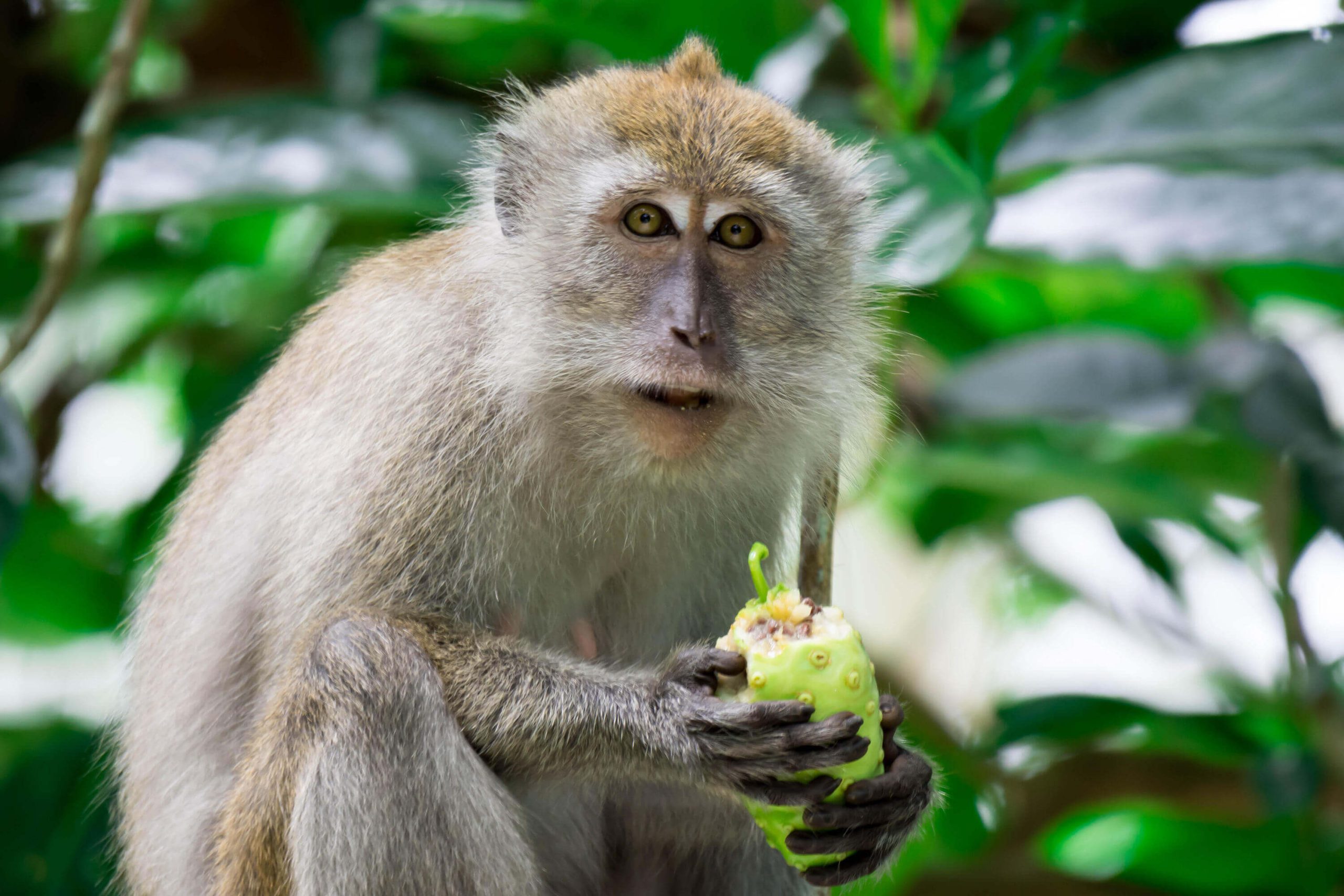
In more serious situations, these animals may gradually be viewed as pests and pressure may be put on the authorities to cull them. So, the next time you spot a cheeky macaque or colourful hornbill, refrain from feeding and simply admire them from afar. Better yet, a more sustainable option is to avoid bringing food along during your hikes. Not only will this help in reducing packaging waste, it will also minimise any potential unpleasant situations with the animals.
3. Jurong Lake Gardens
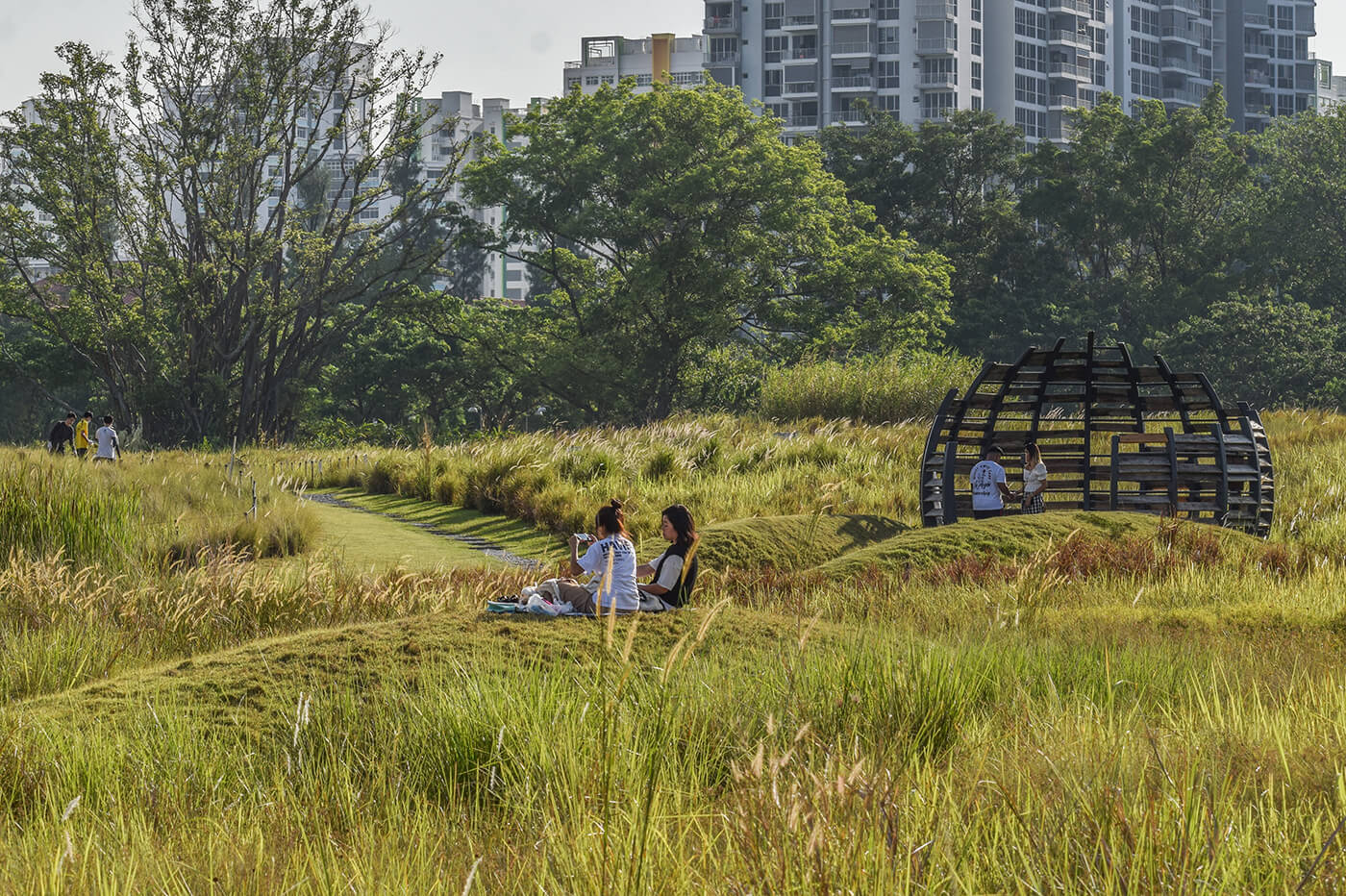
A tranquil lakeside destination, Jurong Lake Gardens is perfect for visitors to enjoy various natural landscapes including an expansive grassland, a freshwater swamp and of course, a freshwater lake.
If you’re an early riser, head down to the Jurong Lake Boardwalk just after the break of dawn to be rewarded with a charming sight of mists over the glassy lake.
Prefer to head down to the park later during the day? Take in spectacular views of the park on Rasau Walk that meanders over the water’s edge or immerse yourself amongst the towering Lalang-like grasses at the grasslands. For the latter, there is even a dome-shape structure where you can rest and observe nature in action! If you’re up for some water sports, check out PAssionWaVe @ Jurong Lake Gardens where a myriad of exciting water activities, such as paddle boating and kayaking, are offered.
Click here for directions on how to get there.
Green Tip: Keep your trash with you
The negative impact of littering goes beyond making our parks look unsightly. Litter, especially plastic, endangers our wildlife as they may mistake these items for food and consume them. By making an effort to not litter even the smallest items like a banana peel, we are keeping these green spaces a haven for our wildlife.
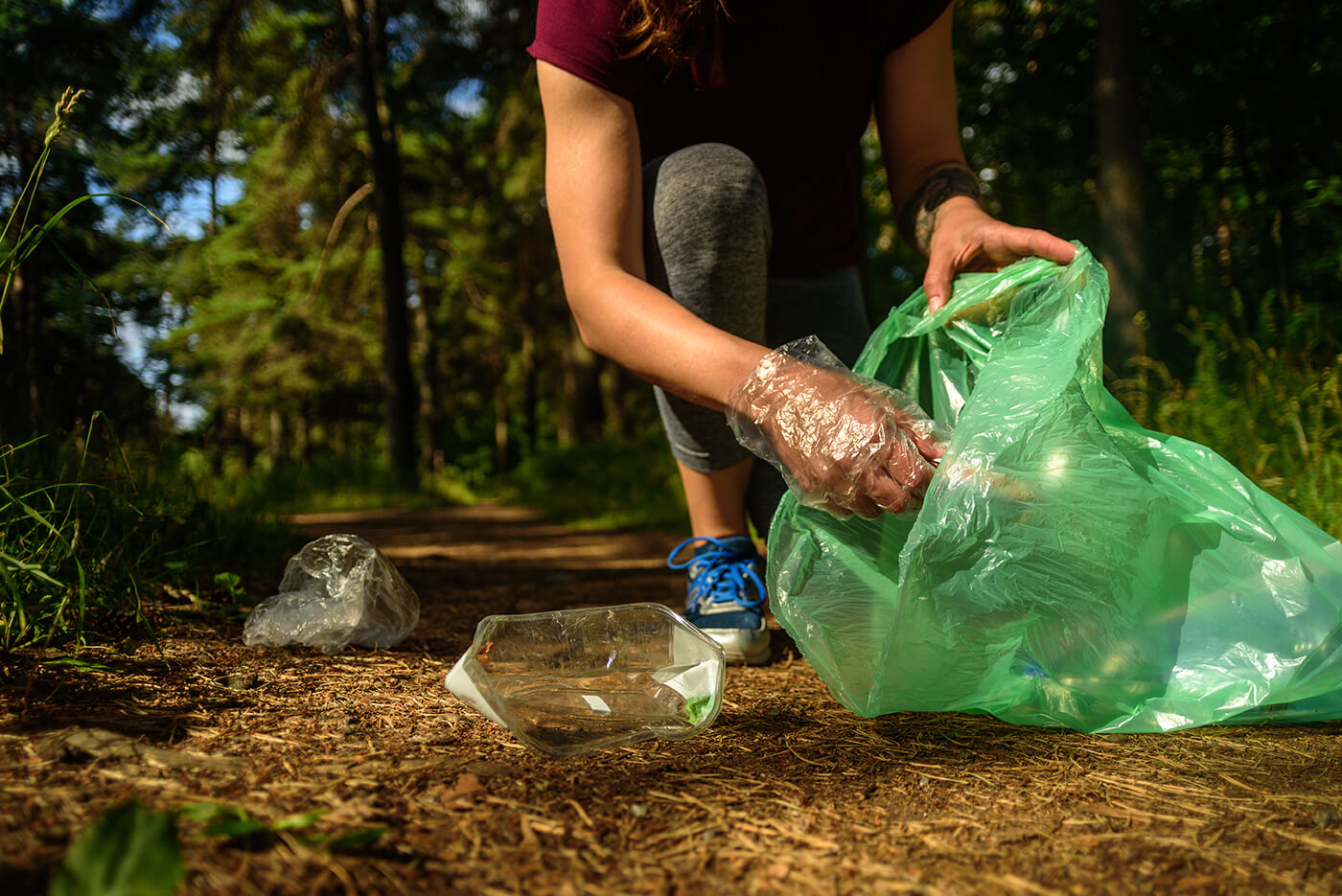
To go a step further, you can even bring along some trash bags and gloves to pick up any litter that you see while hiking. Not only does this help us do good for Mother Nature, it also makes for a great workout!
4. Kranji Marshes
Along the north-western shore of Kranji Reservoir lies Kranji Marshes, a rustic freshwater marshland spanning the size of 60 football fields. This unique sanctuary covers a range of habitats including a freshwater marsh, woodland and grassland. Here, it is home to over 200 species of wild residents as well as a rich variety of flora and fauna – a promising treat for any visitors!
If you’re feeling up for it, climb to the top of the Raptor Tower to enjoy a brilliant bird’s eye view of the surrounding marshes. Between the months of November to March, keep your eyes peeled for migratory species such as the Black Baza and Japanese Sparrowhawk, or spot nationally endangered species such as the Purple Swamphen.
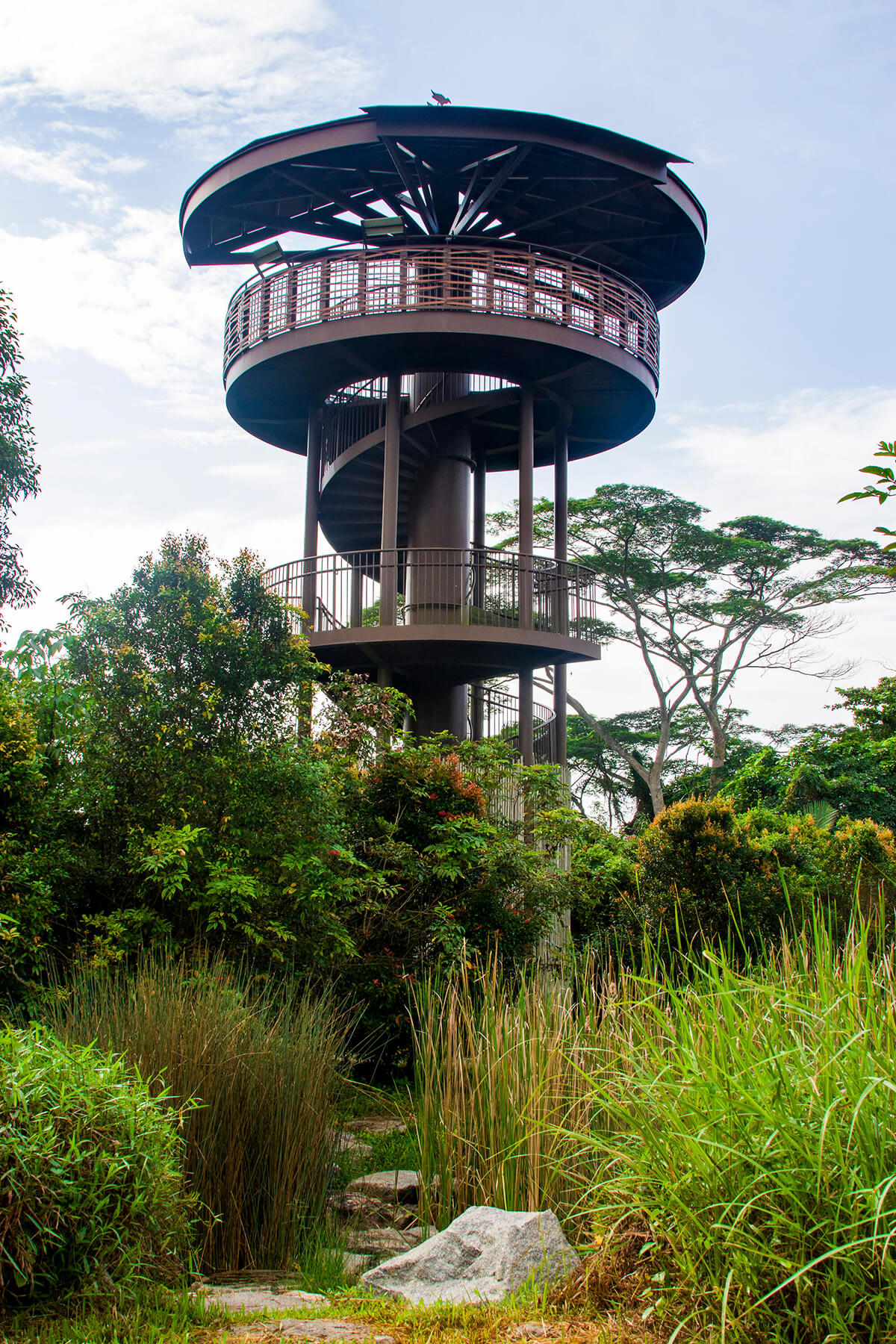
Click here for directions on how to get there.
Green Tip: Opt for eco-friendly sunscreens and insect repellents
Did you know? Sunscreen and insect repellents contain many chemicals that are harmful to our environment. While these chemicals may not have an immediate impact on the trails that you are hiking on, they do cause harm to the natural world in the long run when we wash them off and the water returns our water bodies. For sunscreen and insect repellent sprays, they are also notorious for containing CFCs that destroy the ozone layer.
As such, we would recommend opting for eco-friendly sunscreens and insect repellents such as Sigi Skin’s cruelty and paraben-free sunscreen and Three Star Brand’s Mozzie-Free insect repellent that is made from natural ingredients.
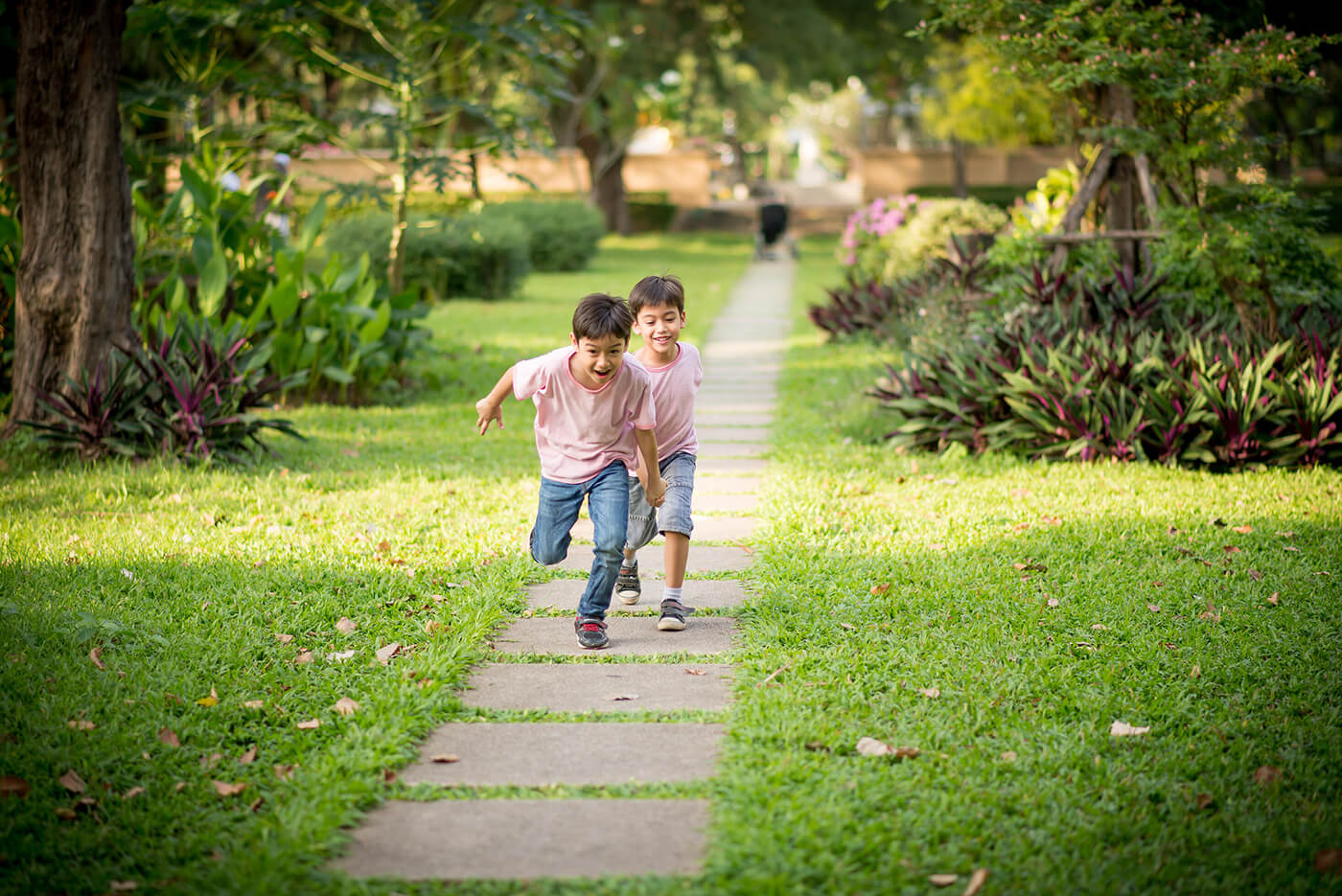
Image Credits: Nylon Coffee Roasters
As you embark on your hiking adventures during the end of year holidays, we hope that these simple tips will help you #PowerTheChange and contribute to the preservation of our green spaces. Every effort counts, and we can all make a difference to protect our precious floral wildlife and fauna for our future generations to enjoy!
Source: The Sustainability Project
References:
- 1 (2019) Climate Healers, Animal Agriculture is the Leading Cause of Climate Change – A Position Paper https://climatehealers.org/the-science/animal-agriculture-position-paper/
4 Top tips to help you embark for a zero-waste kitchen!
- Home
- 2021
[Post Date]
4 Top tips to help you embark for a zero-waste kitchen!

It is no secret that Singaporeans are well-known foodies. As we continue to stay home more amid dine-out restrictions, most of us may have tried our hands in whipping up sumptuous meals, and even baking, in the kitchen.
While cooking at home is typically a healthier and more sustainable alternative than ordering in or eating out, are we really reaping the eco-friendly benefits that home cooking brings? According to the Ministry of Sustainability and the Environment, food waste makes up about half of the average waste disposed of by each household in Singapore daily. Of the food waste, more than half could have also been prevented, with staples such as rice, noodles and bread being the most commonly wasted food items.
In conjunction with World Food Day on 16 October, how about challenging yourself to adopt a zero-waste kitchen, by leaving behind as little food and packaging waste as possible when cooking and dining this month?
There are many ways we can reduce waste in the kitchen and #PowerTheChange. Here, we’ve put together four easy tips to help get you started!
1. Make a weekly meal plan
Always catching yourself staring at your fridge while you ponder over what to cook for dinner? How about breaking the cycle by putting aside an hour during the weekends to plan out your meals for the following week? This will not only help you take stock of what you currently have in your kitchen, it also streamlines the ingredients you require!

For instance, if a whole chicken is sufficient to be spilt across meals for your family, you can plan different dishes that incorporates the entire chicken for the week to reduce any wastage. If your children have their own food preferences, you can also rope them in to brainstorm on what they’d like to have during the week to make meal planning more fun!
By doing so, this ensures that you do not buy any items that you already have in your kitchen, which saves you money and prevent food – especially perishables – from being unnecessarily wasted.
And while you’re at it, keep your loved ones healthy by making these meals a balanced and wholesome one too! Check out these easy guidelines by the Health Promotion Board, where they list down examples of nutrients and the recommended servings needed each day!
2. Purchase from zero-waste grocery stores
In recent years, Singapore has seen a rise in zero-waste grocery stores that offer everything from pasta to tea leaves and soy sauce, sans the plastic packaging seen in regular grocery chains. At these stores, shoppers are encouraged to bring their own reusable containers and fill them up with the groceries they’d like to purchase.
Besides the benefit of reducing the amount of plastic waste generated, it also allows you the flexibility to purchase as much or as little as you need, minimising the amount of food wasted! In addition, these stores, such as Unpackt and Eco.Le, usually source from eco-conscious and socially responsible suppliers, which promises that you’re supporting meaningful causes through your buys.
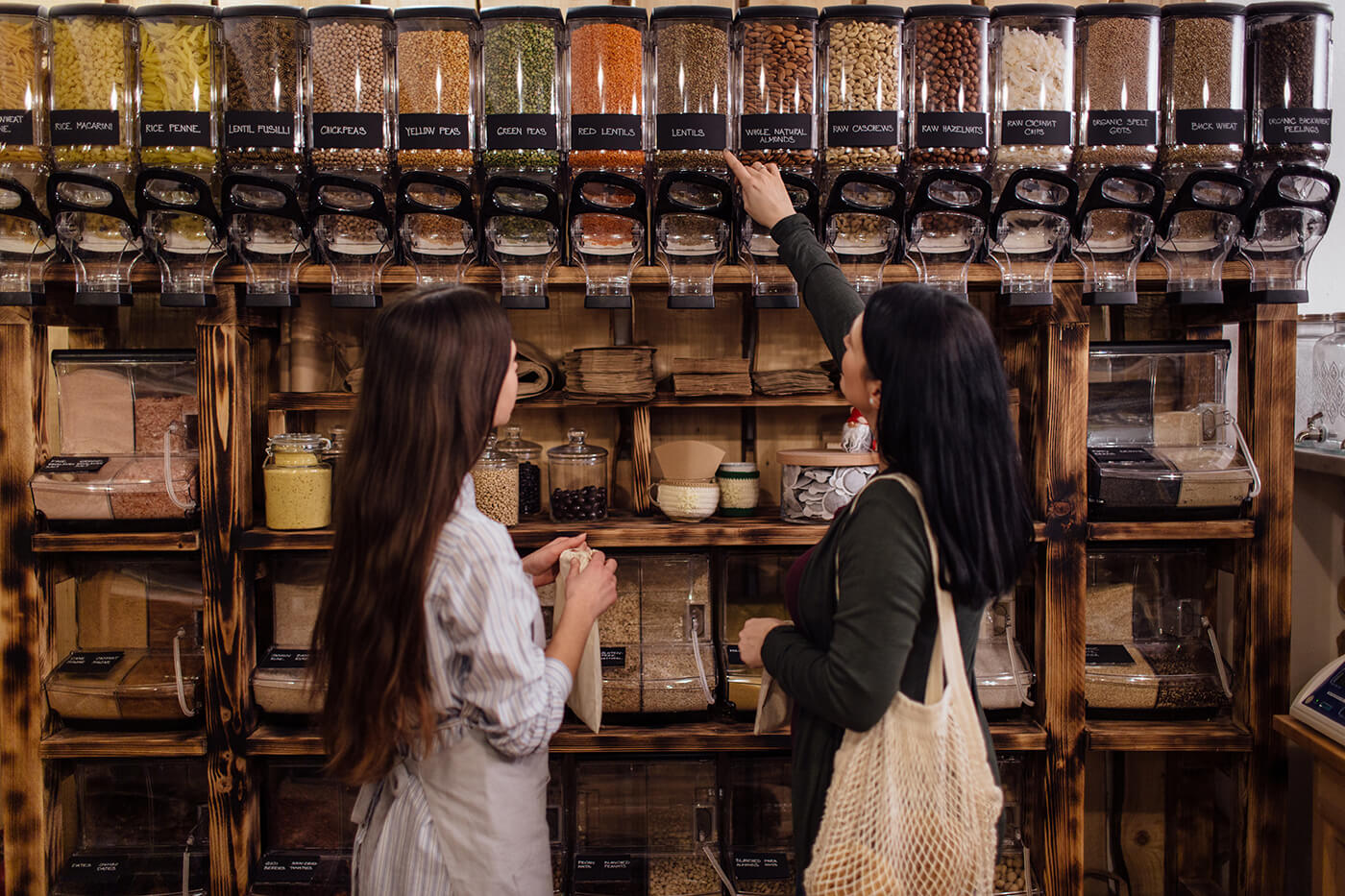
If you’d like to go a step further and go green for your kitchen cleaning products as well, some of these stores also have eco-friendly dishwashing liquid and biodegradable dishwashing sponges!
3. Try growing your own fresh produce
Contrary to popular belief, you do not actually need a lot of space or even a particularly green thumb when growing fresh produce from home! For fruits and vegetables such as cherry tomatoes, chilli peppers and kangkong, they fit perfectly in small spaces (perfect for HDB-living) and thrive under abundant sunlight and the sweltering Singapore heat.
Growing your own produce allows you to harvest the amount you need, instead of purchasing an entire packet from the grocery store and only utilising a portion of it, which would lead to unnecessary food waste. In addition, the process of growing your own produce also deepens the appreciation you have with food, thereby encouraging you to finish consuming every portion to reduce wastage.
Interested to build your little home garden but no idea where to begin? Check out our #ChangeMaker Cultivate Central’s upcoming talk about how you can kick start your home gardening journey!
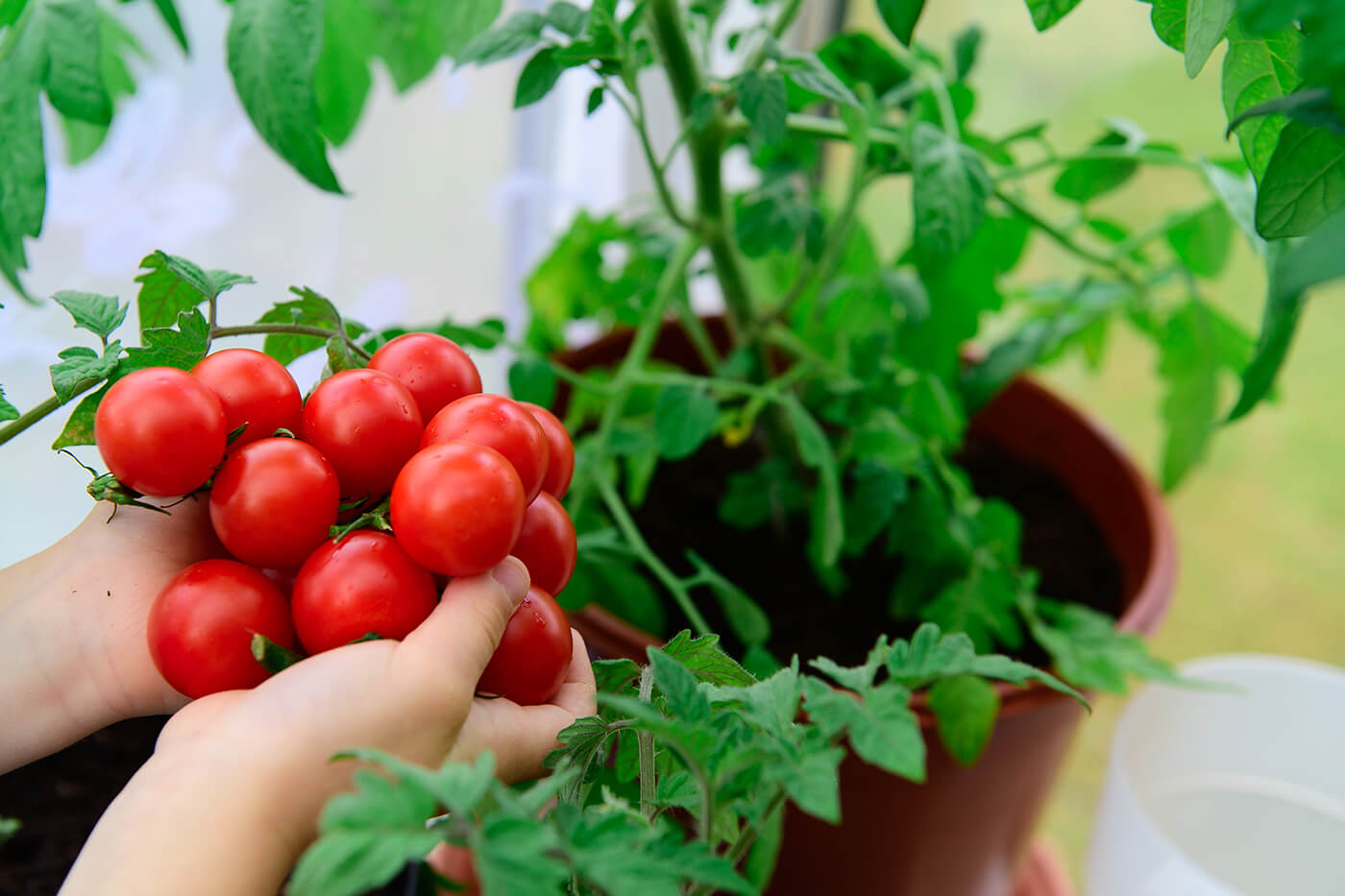
4. Composting any leftover food scraps
A key element of zero-waste kitchen is to use every part of your ingredient, including the leftover food scraps. What can you do with these food scraps, one might ask. How about composting these to create a nutritious fertiliser for your plants or fresh produce; talk about a true circle of life!
With composting, you will also help in keeping these food waste out of the landfill where it is typically broken down by micro-organisms in the absence of oxygen and emits methane, a type of greenhouse gas that contributes to global warming. According to a study by Oxford University, it was found that food wastage was responsible for approximately 6% of global greenhouse gas emissions!
To start, all you need is a bin with a lid, watering can, gardening fork, soil and some dried leaves. You can also check out Cultivate Central’s full composting guide here for more details!
As we celebrate World Food Day, let us take some time to be more mindful in purchasing only what we need and making a conscious effort to finish our meals to reduce food wastage. With each little step, we can together #PowerTheChange for a greener future!
Image Credits: Nylon Coffee Roasters
Source: The Sustainability Project
References:
- 1 (2019) Climate Healers, Animal Agriculture is the Leading Cause of Climate Change – A Position Paper https://climatehealers.org/the-science/animal-agriculture-position-paper/
Sustainable September – 4 Eco-friendly activities to celebrate World Car Free Day!
- Home
- 2021
[Post Date]
Sustainable September – 4 Eco-friendly activities to celebrate World Car Free Day!

In Singapore, there are nearly a million vehicles on our roads releasing a total of 6.4 million tonnes of carbon dioxide emissions every year. That’s equivalent to 320 million trees absorbing carbon dioxide emissions for a year – a significant amount just for our little red dot! Imagine our roads without cars, the quality of our air would no doubt be fresher with noise pollution kept to the minimum.
Each year, World Car Free Day is celebrated on 22 September where cities across the globe rally its urban dwellers to give up their cars for the day. Instead, individuals are encouraged to get around by using public transportation, cycling, or walking. Through this, World Car Free Day aims to highlight the numerous benefits of going car-free such as reduced air and noise pollution, safer roads and the health advantages of walking and cycling.
Prior to the Covid-19 pandemic, cities around the world marked the day with a myriad of creative events held on empty roads from live performances and flash mobs in Jakarta to horseback riding in Sao Paulo. Closer to home, Singapore included its own twist by organising several “Car-Free Weekends” throughout the year with a slew of activities such as film screenings, inflatable play areas for children and even an obstacle course for dogs!
While large events may not be possible during this time, you and your loved ones can still celebrate World Car Free Day with a whole lot of fun. We’ve put together some family-friendly activities that are perfect to help you be a part of this movement.
1. Explore Singapore’s heritage sites on foot
Instead of watching Chinatown, Little India or Kampong Glam pass by in a blur while driving, how about taking the time to explore these beautiful heritage sites on foot? Home to a kaleidoscope of cultures, Singapore features a multitude of breathtakingly preserved architectural landmarks that offer a glimpse into our rich history. Delve deep into the hidden stories of these historic precincts, and we’re sure that you’d discover some fun facts that you’ve not known before.
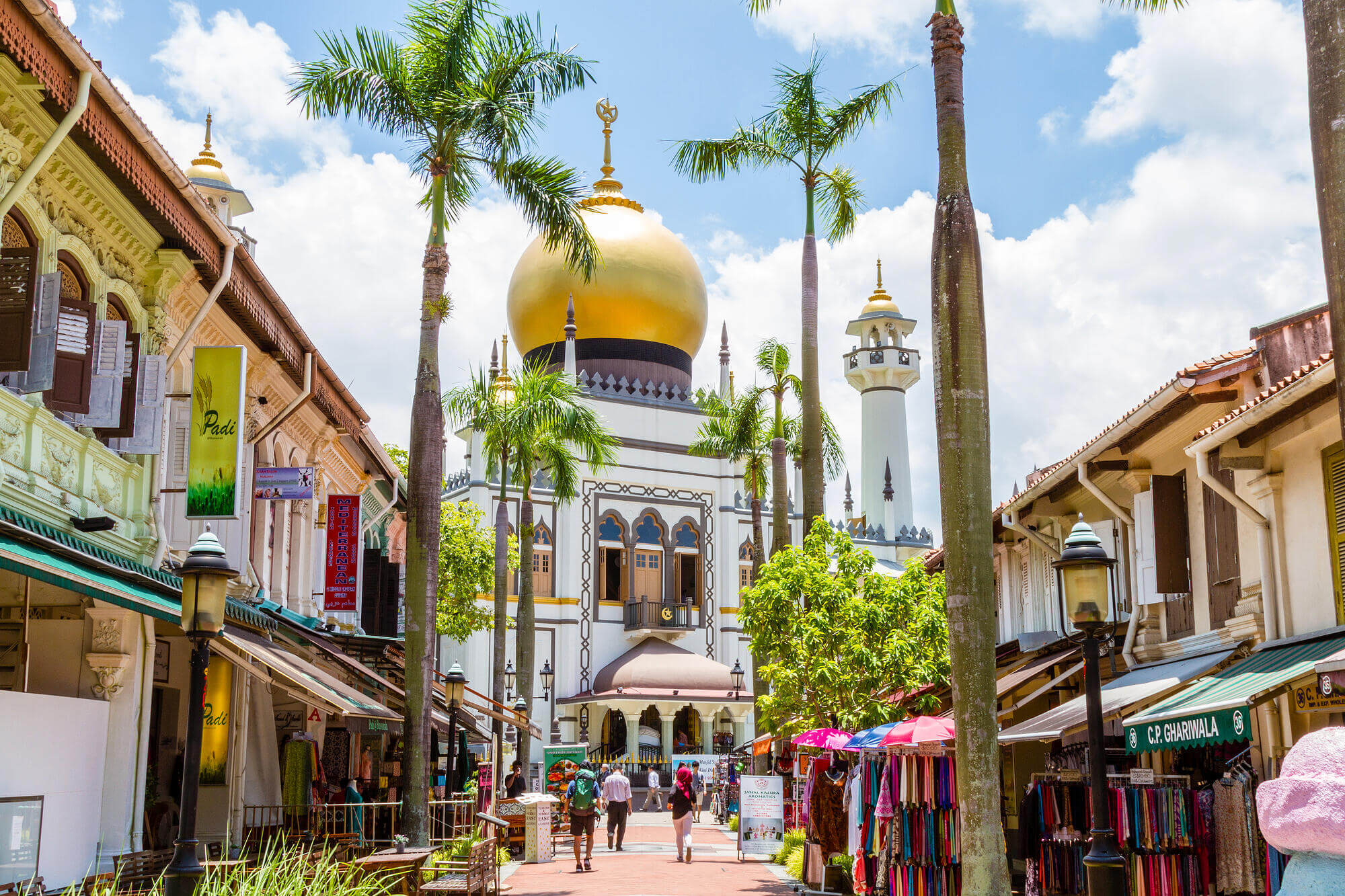
If you’re itching for some retail therapy, these vibrant enclaves also feature an array of eclectic stores that are awaiting to be discovered. Some of our favourites would include the indie boutiques at Haji Lane featuring vintage fashion pieces as well as hole-in-the-wall stores selling the freshest Indian spices at Little India.
2. Get up close and personal with Singapore’s iconic skyline
Singapore is renowned for its stunning skyline that is a mix of old colonial buildings and cutting-edge skyscrapers. If you’ve only admired iconic buildings like Marina Bay Sands and the Fullerton Hotel from the expressways, this is a great chance to get up close by leaving your car behind and hopping on a bike instead!

We would recommend cycling through the Marina Bay loop to tick the boxes off significant landmarks including The Esplanade, Helix Bridge and Singapore Flyer. If you’re up for an extra challenge, you can even extend this route by heading down to Gardens by the Bay and Marina Barrage. For an extra treat, embark on your biking adventure at golden hour and finish at the rooftop of Marina Barrage to enjoy one of the best sunset views in Singapore.
3. Catch the sunrise on rollerblades
If you are looking for something new instead of cycling, how about trying your hand at rollerblading? Singapore’s nature parks and park connectors are paved with smooth routes suitable for rollerblading and there are plenty of rollerblade rental kiosks offering affordable rentals even if you do not own a pair.
To bring your experience up a notch, head down to Punggol Park Connector in the early hours of the morning to enjoy a quiet and serene skate on empty pathways while catching the picture-perfect sunrise by Sengkang Floating Wetland, Singapore’s second largest man-made wetland. A true hidden gem, there are no lack of idyllic spots at the park connector for that unobstructed view of the morning spectacular – easily explored while on your rollerblades!
4. Trek around Coney Island
If you’re feeling a little adventurous, how about venturing a bit further from Punggol Park to explore our neighbouring Coney Island? Easily accessible from Punggol Central, this tranquil island is brimming with rustic charm with picturesque sandy beaches. Best of all, Coney Island is closed to vehicles – the perfect excuse to ditch your car and explore the untouched flora and fauna.

For animal lovers, keep your eyes peeled for an array of birds, crabs and squirrels that call Coney Island home. Bring along your cameras and you might capture some good shots of an eagle soaring overhead or a squirrel nibbling on its afternoon snack! In addition to wildlife, keep a look out the Casuarina Exploration adventure area which was constructed using felled Casuarina trees – an environmentally friendly playground that is fun for all ages!
While World Car Free Day is only marked once a year, we can do our part to #PowerTheChange by choosing more sustainable forms of transportation any day of the year! Each action, no matter how big or small, adds up in our journey towards a cleaner and healthier environment.
Image Credits: Nylon Coffee Roasters
Source: The Sustainability Project
References:
- 1 (2019) Climate Healers, Animal Agriculture is the Leading Cause of Climate Change – A Position Paper https://climatehealers.org/the-science/animal-agriculture-position-paper/
Sustainable September – 5 Tips to reduce and dispose of your e-waste!
- Home
- 2021
[Post Date]
Sustainable September – 5 Tips to reduce and dispose of your e-waste!

Regarded as the world’s fastest-growing trash stream, e-waste has now become a common sight at rubbish collection points and landfills, especially for smart cities like Hong Kong and Singapore. For most of us, we’ve probably not given much thought when we discard our old phone or computer for a newer, sleeker model, or change an old home appliance to a new one. However, with each upgrade, we are contributing to the ever-growing pile of e-waste every year.
According to the National Environment Agency report in 2018, Singapore generates 60,000 tonnes of e-waste annually. That’s comparable to each of us disposing 73 phones every year! Since our everyday electronics are often laced with lead, mercury, or other toxic substances, these can cause serious damage to our environment and our public health if they are not disposed properly.
As we explore various ways to #PowerTheChange for a #SustainableSeptember, there’s no better place to start than what’s in your household bin. We have compiled a few easy ideas on how you can effectively reduce your e-waste by giving your electronic items a new lease of life and challenging yourself to think twice about your next electronic purchase.
1. Donate your pre-loved electronics

On average, electronic devices usually have a lifespan of between 4 to 5 years. However, being a tech-savvy nation, we often upgrade our phones and laptops in just a couple of years, which may still be working perfectly well!
Instead of simply throwing them out, how about passing them on to someone else who may need it? Locally, there are many non-profit organisations such as Engineering Good that collect, refurbish and distribute secondhand electronic devices for individuals in need. By donating your old electronics, not only will it help underprivileged families have equal access to such digital devices, it also prolongs their lifespan, thus conserving our natural resources.
2. Exchange them for cash
With more than 100 Cash-for-Trash stations available island-wide, which collect recyclables including small electrical appliances that are considered as unregulated e-waste, you can easily find one that’s near you and exchange your items for cash! These incentive programmes not only help you do good for the environment; it even rewards you for doing so!

Alternatively, you can also consider selling or trading your old gadgets with other like-minded individuals via online sites such as Carousell, or even join a Facebook group to organise an online garage sale within your local neighbourhood!
You might be surprised at how many online groups with collectors are willing to pay good money for older electronics such as old film cameras or Gameboys, and who knows? You may even make some new buddies along the way!
3. Repair before Replace
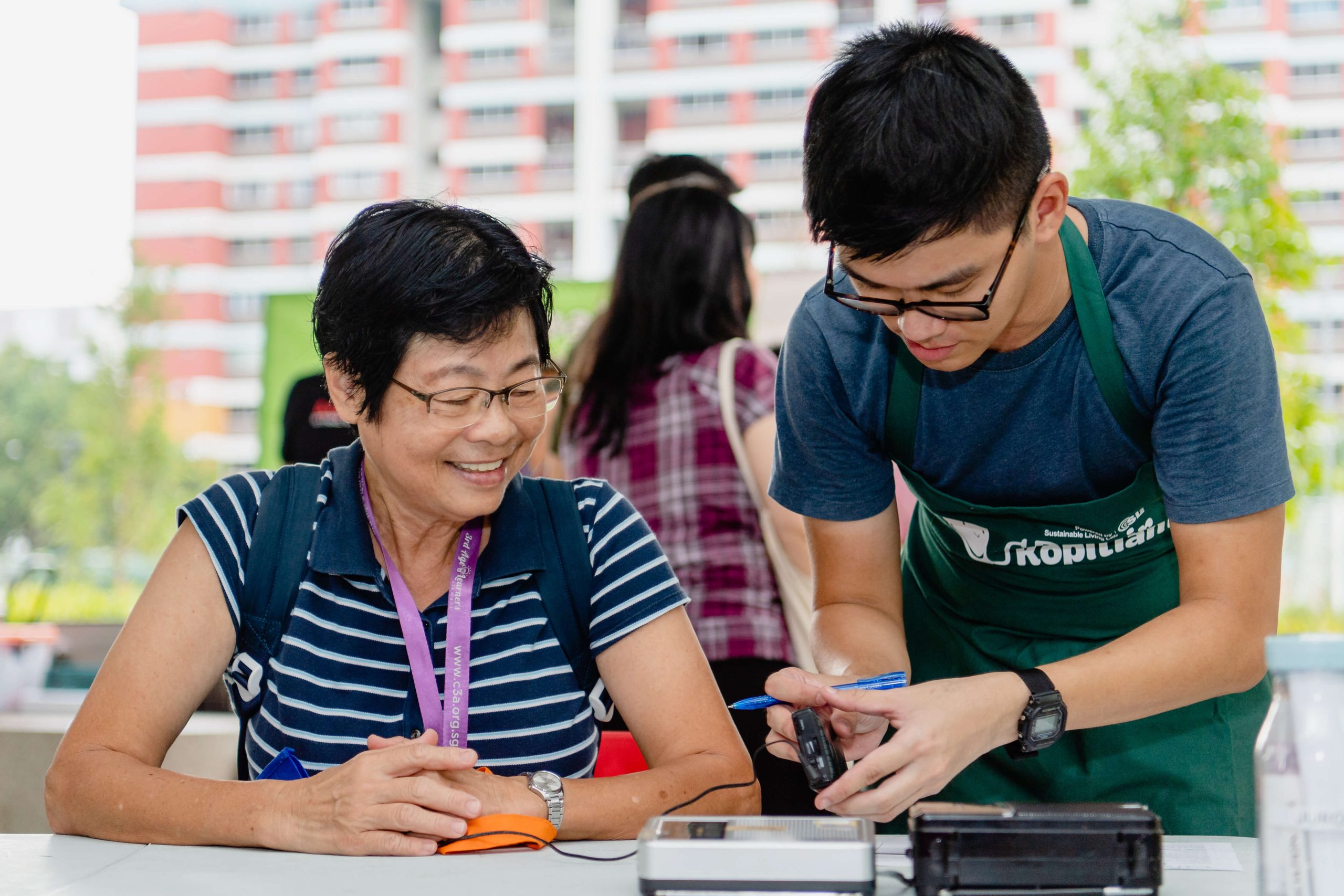
Beyond personal devices such as mobile phones and computers, a huge percentage of electronic waste also comes from home appliances, such as washing machines, air-conditioning units and hair dryers.
Given the abundance of affordable options we have today for our electronics, it is not unusual for us to want to replace them when they seem to be broken or spoilt.
However, as we take a step towards incorporating more sustainability practices within our lifestyles, how about challenging yourself to pick up that toolbox? While there are no shortages of tutorial videos on YouTube, you can also consider signing up with our ChangeMakers Repair Kopitiam to learn how to diagnose and fix your broken electronics!
Repair Kopitiam hosts monthly workshops at various venues across Singapore and aims to equip individuals with basic technical skills to repair their items. While not all items can be restored to their 100%, the skills and knowledge you obtain from these repair sessions will no doubt help tackle the “buy and throw away” practice that is ingrained in our modern society, and pave the way for a more sustainable world.
4. Buy only what you need
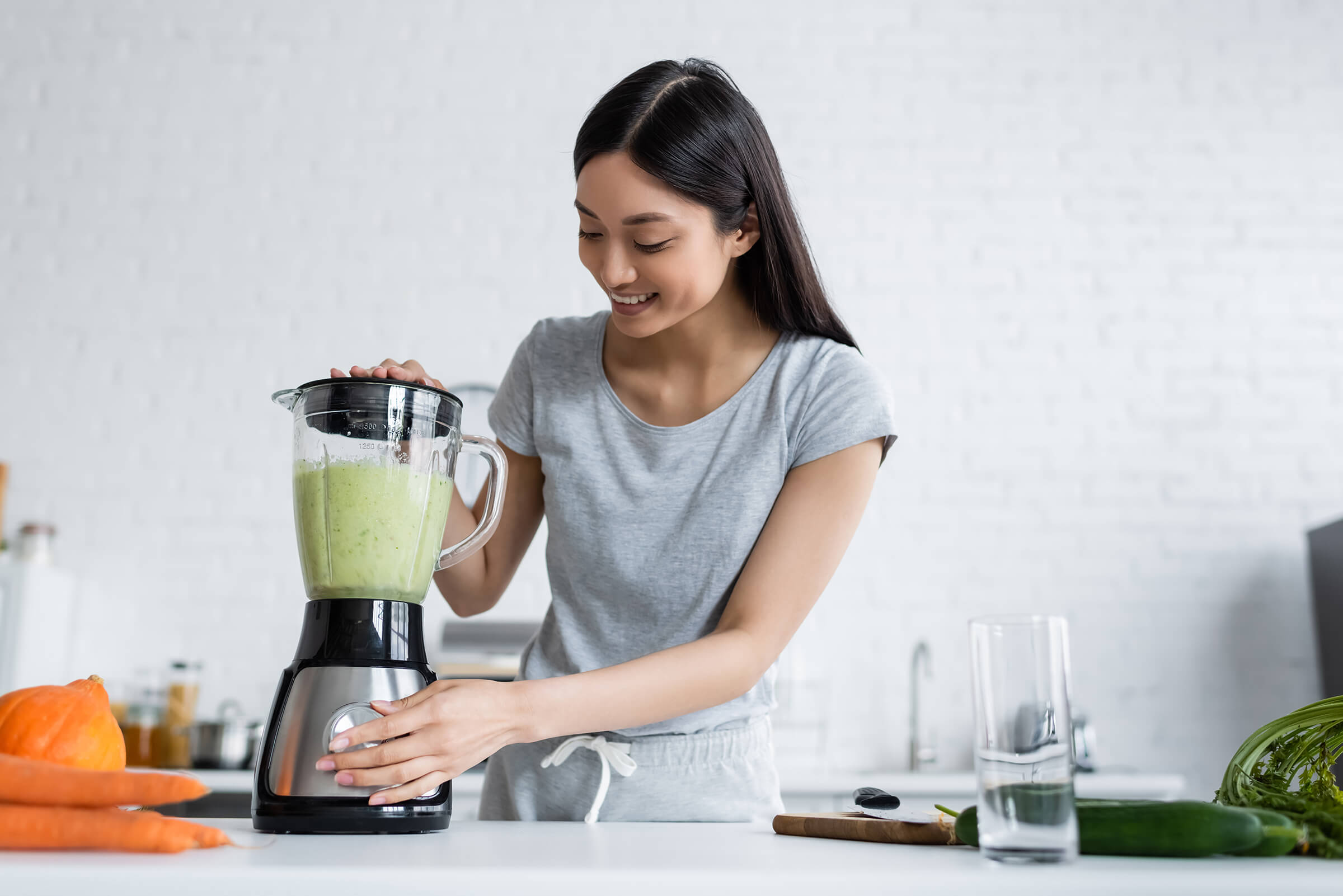
Tackling the e-waste problem is not just about being more conscious of our post-purchase behaviour, it starts with the mindset we have towards our buying habits. Instead of being swept off by the convenience of e-commerce and giving in to impulsive buys, how about making the conscious effort to purchase more mindfully?
Before every purchase, it is important to be aware of what you already own, and then ask yourself this – is this item a ’want’, or a ‘need’ ? By going through this process, it helps you curb the urge to buy an electronic device just to keep up with the latest technology trend, and reduces your e-waste contribution over time!
5. Recycle at designated bins and drop-off point
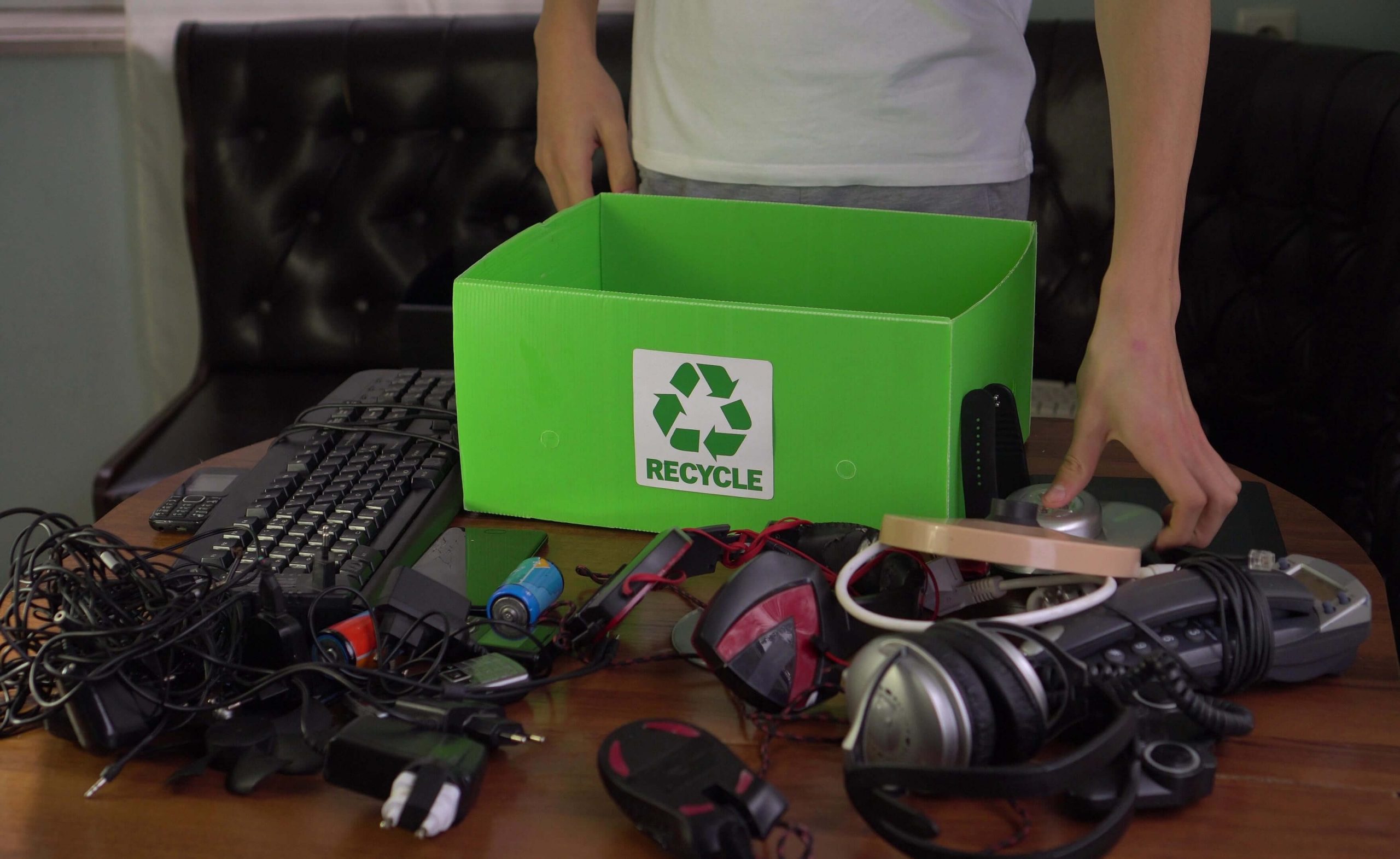
Despite best efforts to repair or donate our electronic devices, there comes a time when we need to eventually dispose of them. Given the toxic substances that are present within each electronic, which can be damaging to both humans and the environment, it is important for us to know how to dispose them correctly.
Singapore has identified e-waste as one of the priority areas under Singapore’s Zero Waste Masterplan, which aims to reduce one-third of the waste sent to our landfill by 2030. Working towards a zero-waste nation, the National Environment Agency has appointed ALBA E-Waste Smart Recycling to lead this green cause and handle our e-waste challenges properly.
With more than 300 collection bins scattered around the island, where you can deposit all your non-working and recyclable electronic devices – including items such as your computer monitors, electronic toys, LED lightbulbs, there’s really no excuse not to recycle them responsibly!
Every action matters to #PowerTheChange for our environment. By doing our part to lower our e-waste, we can make a big difference in our carbon footprint and help preserve our Earth’s resources in the years to come.
Image Credits: Nylon Coffee Roasters
Source: The Sustainability Project
References:
- 1 (2019) Climate Healers, Animal Agriculture is the Leading Cause of Climate Change – A Position Paper https://climatehealers.org/the-science/animal-agriculture-position-paper/
Go Green Your Way – Four reasons to support local eco-friendly organisations
- Home
- 2021
[Post Date]
Go Green Your Way – Four reasons to support local eco-friendly organisations

When the COVID-19 pandemic took the world by surprise since last year, the nation’s economy was affected significantly and we witnessed the vulnerability of local businesses and small and medium enterprises within the year. Amidst the pandemic, another pressing issue was also brought to the forefront – Climate Change.
From what seemed like a trying time, a silver lining emerged and we saw global emissions fell a record of 7%. Witnessing this significant reduction, the world grew even more aware of the importance of being eco-friendly and its effects on global warming. More Singaporeans also took notice of local businesses with a green mission to meet these increasing demands for sustainability.
And here are 4 reasons why you should continue to show your support for our eco-friendly organisations, especially in these challenging times, and #PowerTheChange for a greener environment!
1. Reduce your carbon footprint
In a recent report by McKinsey & Company, the fashion industry contributed about 2.1 billion tonnes of greenhouse-gas (GHG) emissions in 2018, which is about the same quantity of GHGs per year as the entire economies of France, Germany, and the United Kingdom combined. Without any action taken, the emissions are predicted to grow to 2.7 billion tonnes a year by 2030.
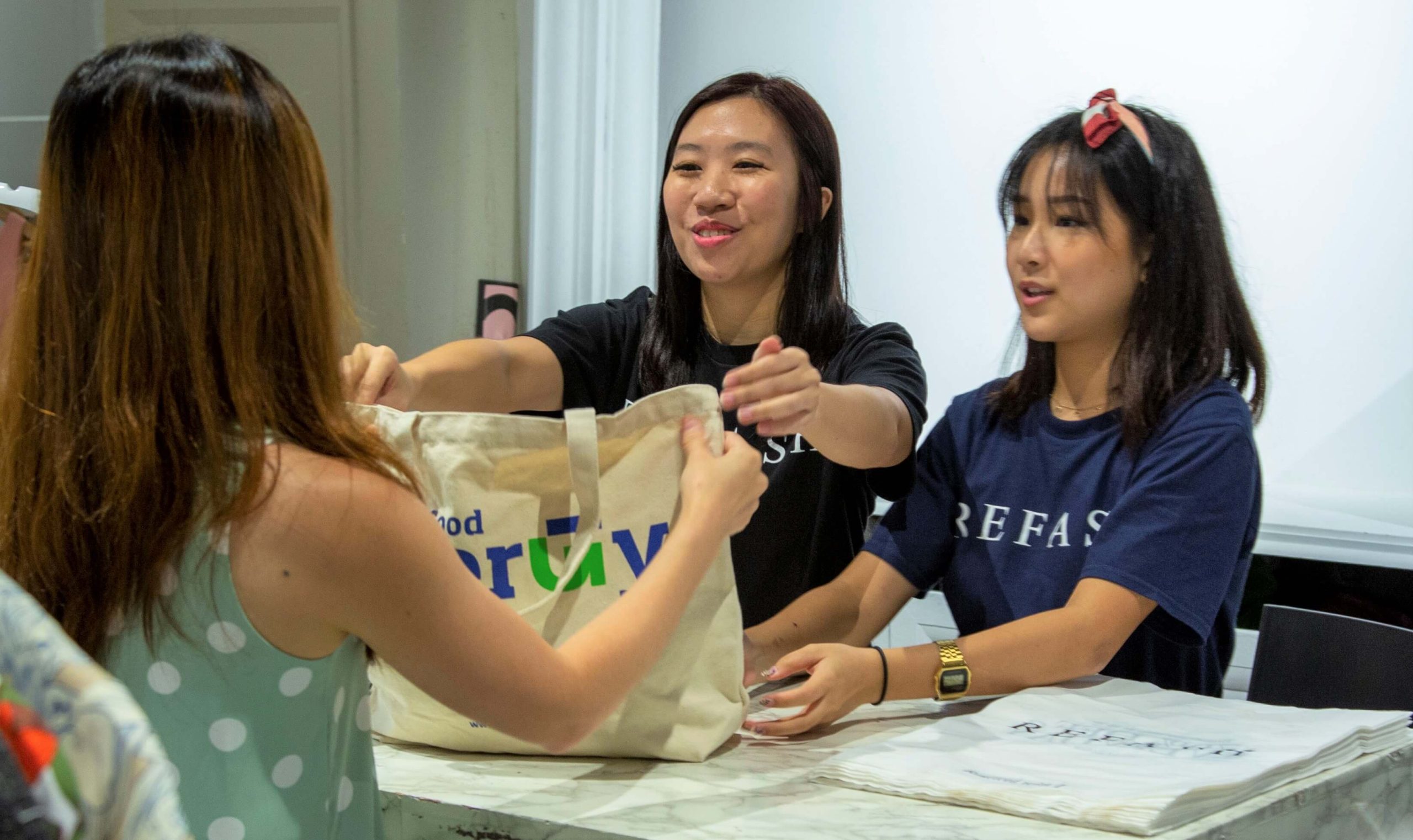
While brands and retailers are the main driving forces to mitigate the greenhouse-gas contributions, consumers can also play their part to #PowerTheChange and make a difference for the environment.
Which is why fashion retailers like our ChangeMaker, REFASH, are trying to change consumers’ buying behaviours and pave the way for a more sustainable fashion future. By giving new life to pre-loved apparels and reselling them, they have saved over 1.5 million pieces of clothing and displaced 100,000 tonnes of carbon dioxide equivalent since 2015.
To help our customers reduce their carbon footprint even further, we have also partnered with REFASH, as part of their BYOB initiative, to give away complimentary Geneco tote bag (made from 100% recycled material) when you make a purchase of any pre-loved item at their stores. Simply show your Geneco e-bill to redeem the bag!
2. Improves our nation’s food security and creates job opportunities
Singapore imports over 90% of the food we eat, with some of our fresh produce and meat coming from other countries as far as Brazil, which makes us dependent and vulnerable to their supplies and price disruptions. Adding on to the dependency, the onset of the pandemic last year also further highlighted the importance for our homeland’s food security.
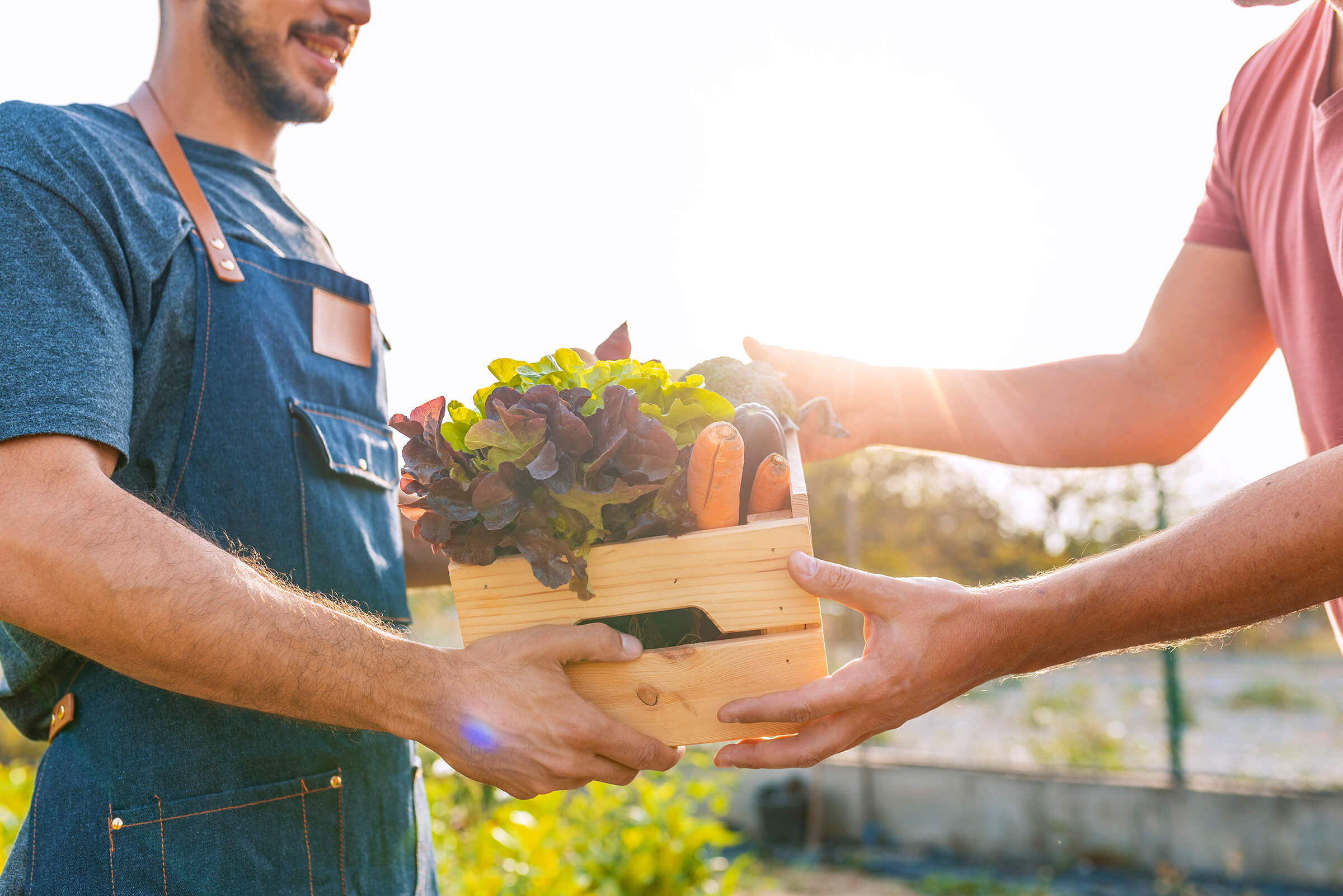
Realising this importance, Singapore set a 30 by 30 goal as part of our Singapore Green Plan 2030 and local farmers have been working hard since then to produce 30% of our nutritional needs locally and sustainably by 2030.
To help meet this goal as well, another of our ChangeMakers, Comcrop, have also expanded their urban farming facilities and continues to partner with senior citizens and other members of the community to help grow their crops whenever possible.
With your support and purchases of their local produce at Fairprice Finest stores and Redmart online, not only are you helping to improve our economy and creating more job opportunities, you are also contributing to our nation’s green goal!
3. Promotes circular economy and zero-waste
In the current linear economy structure, which we are all familiar with, the ‘take-make-dispose’ method often result in large amount of waste and causes a huge strain on our natural resources. A circular economy on the other hand, aims to reduce waste to the minimum and reuse these precious resources for as long as possible.
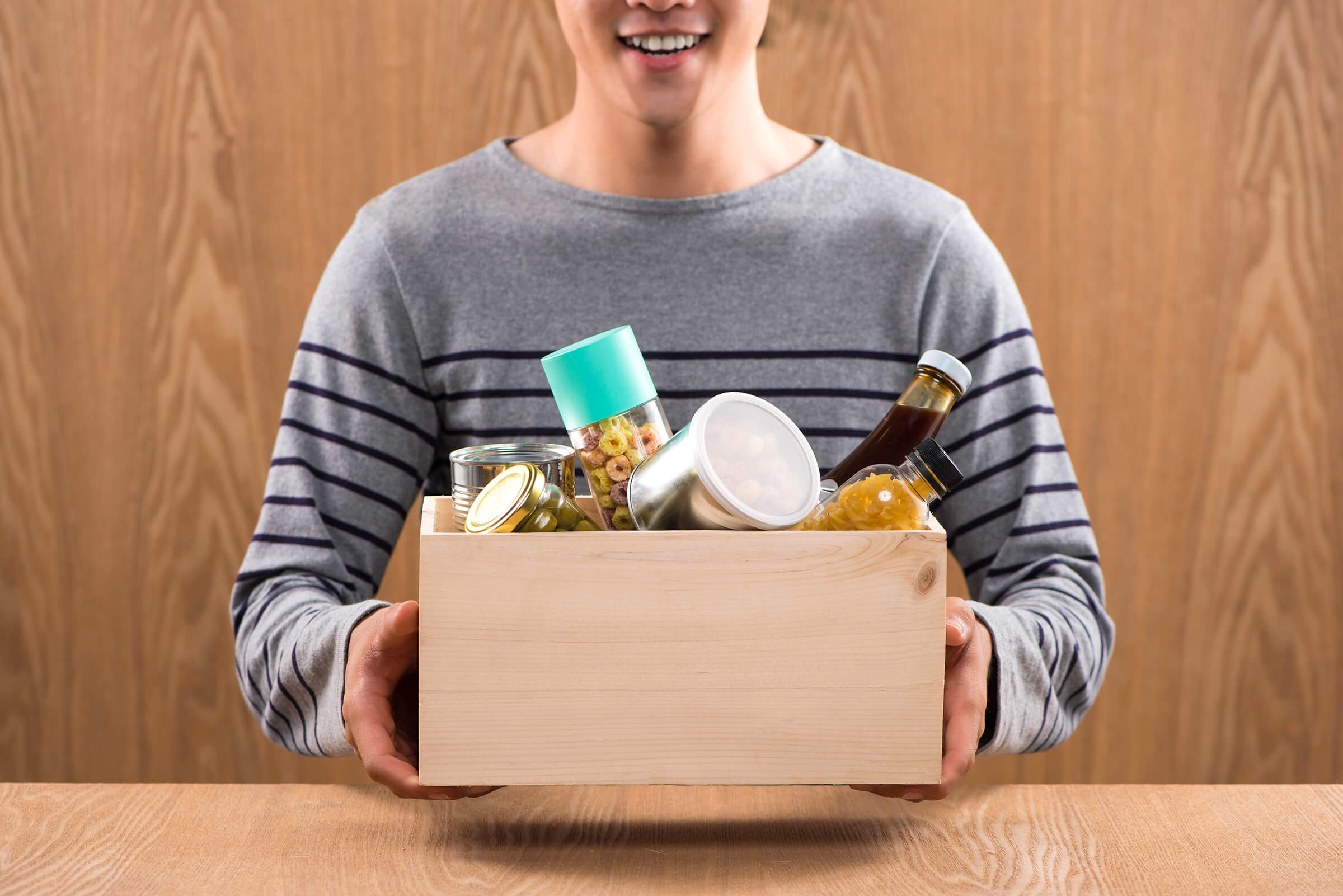
Working towards our zero-waste vision by adopting the circular economy approach, our nation has identified 3 key resource loops – Food, E-Waste and Packaging to act on, in order to lessen our impact on the environment. Our ChangeMakers, The Food Bank Singapore and Repair Kopitiam, are striving exactly towards this vision.
If you find yourself disposing untouched or unopened food on a regular basis, why not consider donating them? Through Food Bank’s Donation Boxes, which are available island-wide, this excess food can be put to good use when distributed to their large network of beneficiaries.
And to help you cultivate a repair mindset, why not join Repair Kopitiam’s latest project eRevival Square, where you can learn how to reduce your e-waste and take a pledge to solidify your commitment? Alternatively, you can also sign up to be a repair coach and help others make a positive impact!
4. Provides customised service
Local businesses usually tend to have a smaller customer base compared to big national retailers, which means they are likely to go above and beyond to add more value to customer service.
Green Nudge, a leading green social enterprise in Singapore believes that lasting environmental impact can only be achieved collectively, which is why they have designed various sustainable services that can be customised to the needs of companies and communities.

In support of their mission, we have also collaborated with Green Nudge by sponsoring their Coastal Cleanup Toolkit for our customers! Check out our PowerUp Rewards page to find out how to redeem this reward and join in on their green efforts!
Here at Geneco, we believe in building a more sustainable home for our future generations. Not only do we support like-minded organisations and our ChangeMakers in their environmental cause, we also believe in empowering our customers to #PowerTheChange for the environment.
With our Power Eco Add-on, Singapore’s first-and-only customisable and green add-on for an electricity plan, we want to encourage and help you #gogreenyourway with a choice between Carbon Credits (CC) and Renewable Energy Certificates (REC) to offset/avoid up to 3,920 kg of CO2, which is equivalent to the absorption of carbon emission by 192 rain trees!

Taking the first step to a greener future has never been easier and more affordable. From just 40cents more per month, you can choose your level of green contributions – 25/50/75/100% when you sign up with any of our electricity plans. You are then off to a great start on your eco-lifestyle in less than 5 minutes!
What’s more, you will be assured with an official Green Certificate for your contribution to the environment, plus the first 1,000 sign-ups for our 24-month price plan will also receive exclusive Geneco Green Starter Kits!
Every action counts in our combat against climate change – you can start by supporting local eco-warriors and their green beliefs or by simply adopting small changes in our daily habits. With a cumulative effort, we can #PowerTheChange and make a big impact on our planet.
Image Credits: Nylon Coffee Roasters
Source: The Sustainability Project
References:
- 1 (2019) Climate Healers, Animal Agriculture is the Leading Cause of Climate Change – A Position Paper https://climatehealers.org/the-science/animal-agriculture-position-paper/
Go Green Your Way – Show your love for Singapore with these 5 ways of living sustainably
- Home
- 2021
[Post Date]
Go Green Your Way – Show your love for Singapore with these 5 ways of living sustainably

Singapore has always pride itself as a clean and green city. Since our independence, our founding fathers have made it a priority to put Singapore on the path of sustainability and provide a high-quality living environment for all Singaporeans. From enduring efforts to green our city-state to transforming urban water catchment areas into vibrant spaces and plans to ramp up public transport infrastructure to encourage a “car-lite” lifestyle, present-day Singapore has consistently been recognised as one of the greenest cities in the world.
It is undeniable that Singapore has come a long way over the past 56 years. As we celebrate National Day this year, what better way to express our love and appreciation for our country than to #PowerTheChange and build a greener tomorrow for our future generations?
We’ve put together five easy ideas for you to make a difference as our nation furthers its green goals for a more sustainable future.
1. Keeping Singapore’s spaces clean by picking up litter
With the current work arrangement, many of us have been staying indoors most of the time and heading out for a quick jog in the evenings is a form of respite after a long day’s work. Besides working up a quick sweat, how about making more of your outdoor jog by keeping your running tracks clean?
Known as plogging (jogging while picking trash), it not only helps us do good for the environment but offers many extra health benefits! According to a Swedish fitness app Lifesum, plogging burns 53[1] more calories than just jogging. The extra movements of bending down and picking up trash adds up to make a great workout.[1]
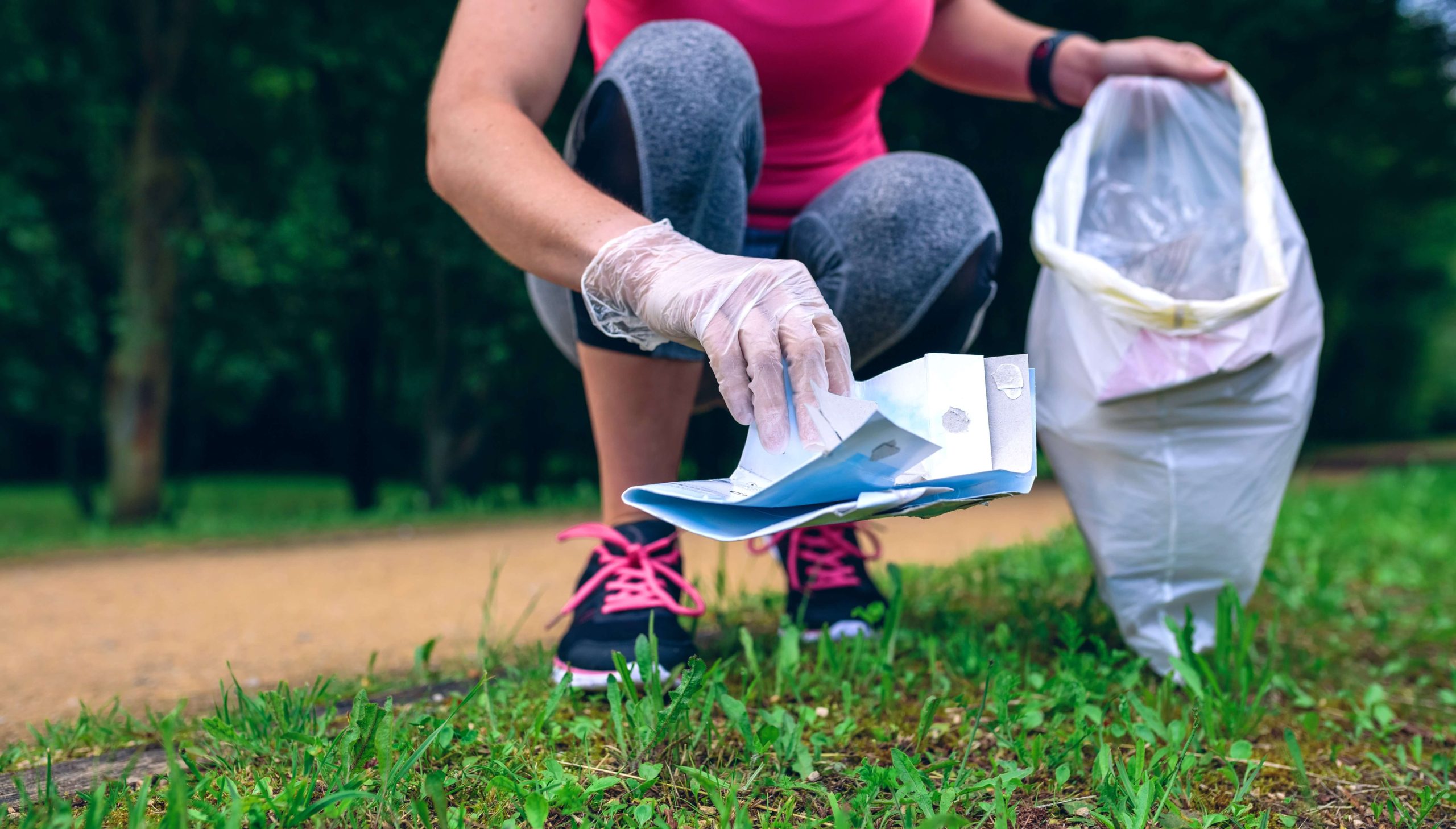
To get started, all you need is a trash bag, some gloves, masks and tongs. Once you’ve filled up your bag, you can either recycle or throw it away depending on the contents you’ve picked up. While making a difference in the cleanliness of your neighbourhood, remember to keep to safe distancing measures and stay safe!
2. Plant-a-Tree to contribute to Singapore’s lush greenery
Singapore has made a pledge to plant a million trees across our island over the next decade and bring the total number of trees in Singapore to more than 8 million. Trees play an important role in creating a conducive living environment by providing natural shaded areas and serving as natural air filters. With the ramp up of this nationwide effort, it will not only further beautify our urban environment, but also increase our country’s resilience towards climate change.
Here at Geneco, we are proud to be doing our part for this movement. Earlier this year, we have committed to plant 250 trees over the next five years as part of NParks’ One Million Trees Movement as we launched our Power Eco Total Home Solution. We’ve planted our first 50 trees at Windsor Nature Park on Earth Day together with our ChangeMakers and corporate partner Standard Chartered Bank to #PowerTheChange.
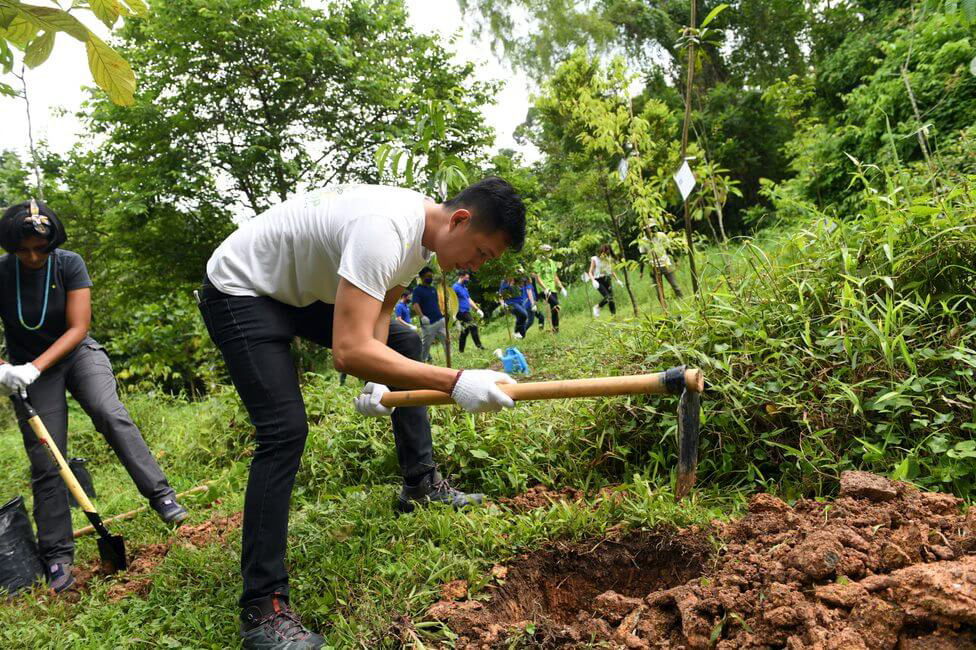
Looking for a way to contribute and be a part of this movement as well? You can do so by donating the cost of a young tree towards NParks’ Garden City Fund or volunteering your time to help in forest restoration works or outreach programs. With each tree planted, it brings us closer to our City in Nature vision.
3. Donating old laptops to help individuals from low-income families
As the Covid-19 pandemic continues shifting our daily activities online, individuals from low-income families may not have equal access to digital devices such as laptops to remain connected. These individuals include students who have shifted to home-based learning as well as adults who may be looking for employment through online job databases.
Instead of throwing out our old laptops, how about donating them to Engineering Good’s Computers Against Covid initiative? This non-profit organisation collects, refurbishes, and distributes second-hand laptops to families in need. While Engineering Good has distributed more than 4000 laptops since May 2021, they are still regularly trying to fulfil an average of 150 to 200 laptop requests each month, so every laptop donation counts!
Should your laptops be of the older models which are no longer suitable for use or donation, recycle them appropriately at the e-waste bins available across our island. You may even earn points that can be redeemed for shopping vouchers when you recycle your e-waste at these bins!
4. Extending the lifespan of Semakau landfill by reducing waste
According to the Ministry of Environment and Water Resources, the lifespan of Singapore’s only offshore landfill is getting shorter by the minute. At the country’s current rate of waste generation, Semakau Landfill is expected to be fully filled by 2035 which would spell trouble for our land-scarce island.
With the renewed goal of reducing waste sent to our landfill by 30% by 2030, do your part to be more socially conscious in the amount of waste you discard! Some easy ways include purchasing pre-loved goods, opting for reusable items, and composting your food waste. The idea is to design a circular economy and maximising the value of our resources by keeping them in use for as long as possible.

5. Contributing to Singapore’s goal to shift towards greener energy
As part of the Singapore Green Plan 2030, our Lion City is taking significant steps to transition towards greener energy. Some goals include quadrupling the nation’s solar energy deployment by 2025 and tapping on green energy sources from overseas through electricity imports.
Strengthening our commitment to the nation’s green plan, we recently launched Power Eco Add-on – Singapore’s first-and–only customisable green add-on for an electricity plan to help you #gogreenyourway.
To encourage and ease Singaporeans into embarking on an eco-friendly journey to build a greener home for all, this green add-on was conceived with five key benefits in mind:
- Flexibility – The freedom to choose between Carbon Credits (CC) or Renewable Energy Certificates (REC) as a way to lower your carbon footprint.
- Affordability – A choice of 25/50/75/100% level, so you can do your part for the environment from as low as 0.1cents/kWh. That’s just $0.40 more for each month!
- Impact to the environment – Offset up to 3,920kg of carbon emissions. That’s equivalent to 192 rain trees absorbing CO2 in a year!
- Simplicity – Signing up takes less than 5 minutes and you’ll be off to a great start to an eco-lifestyle. It’s that easy.
- Authenticity – Receive an official Green Certificate for your contribution to the environment. And yes, it’s a digital e-cert.
We are also giving away free Geneco Green Starter Kits to the first 1000 sign-ups of the 24-month plan with Power Eco Add-on! Each Starter Kit consists of items such as a reusable grocery net bag, collapsible silicone water bottle, 100% recyclable foldable umbrella and silicone straw to help you in replacing the use of single-use plastics! Click here to find out more!
As Singapore continues its march towards the next 50 years, the road ahead will no doubt be challenging as we deal with the imminent pressures brought about by climate change and strained resources. However, if we each play a part and continue building upon the hard work of our forefathers, we can make a difference and #PowerTheChange for a cleaner and greener city for Singaporeans today and generations to come!
References:
- [1] (2018, October 7) The Straits Times, Go 'plogging' to get fit and do good https://www.straitstimes.com/singapore/environment/go-plogging-to-get-fit-and-do-good
Image Credits: Nylon Coffee Roasters
Source: The Sustainability Project
References:
- 1 (2019) Climate Healers, Animal Agriculture is the Leading Cause of Climate Change – A Position Paper https://climatehealers.org/the-science/animal-agriculture-position-paper/
